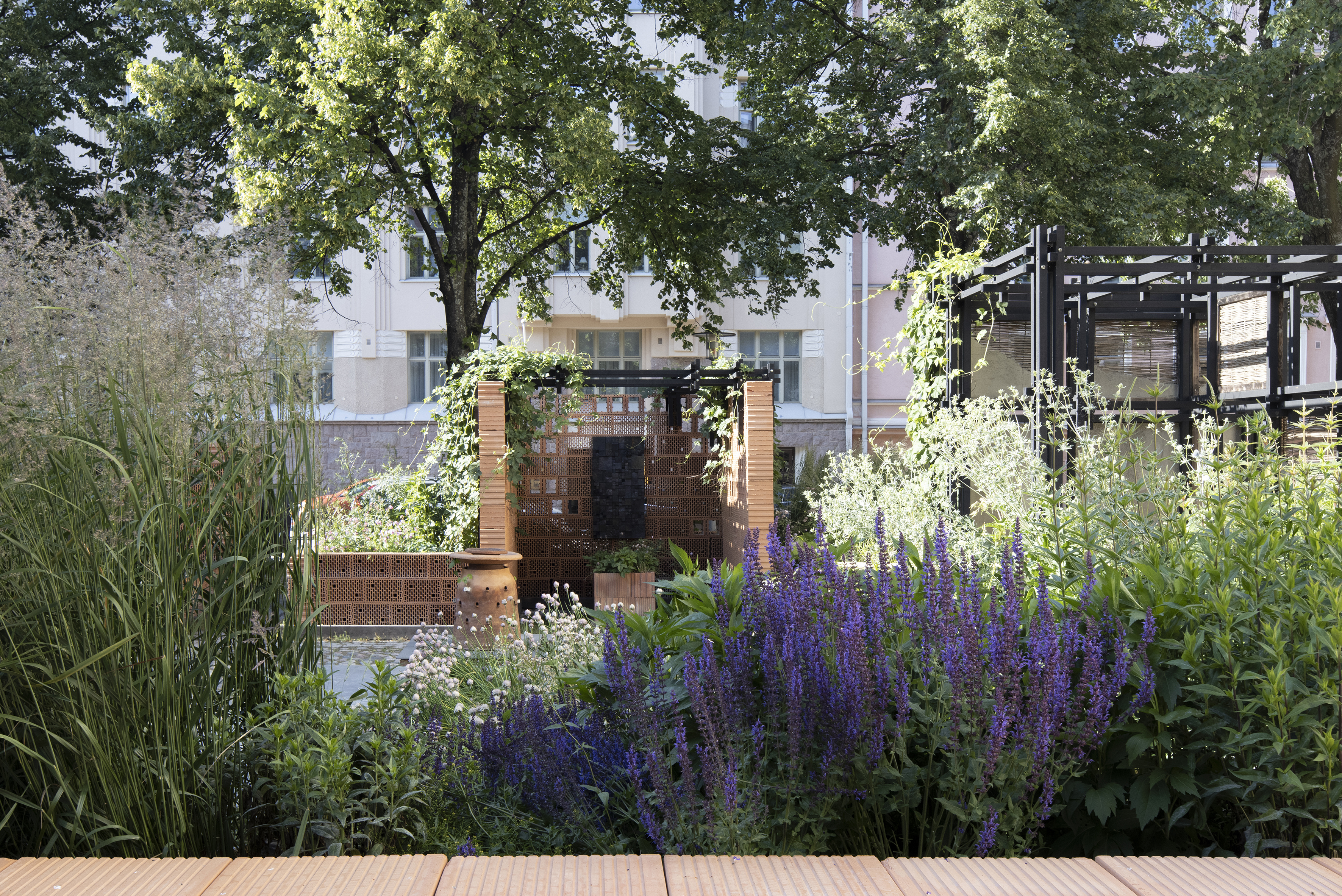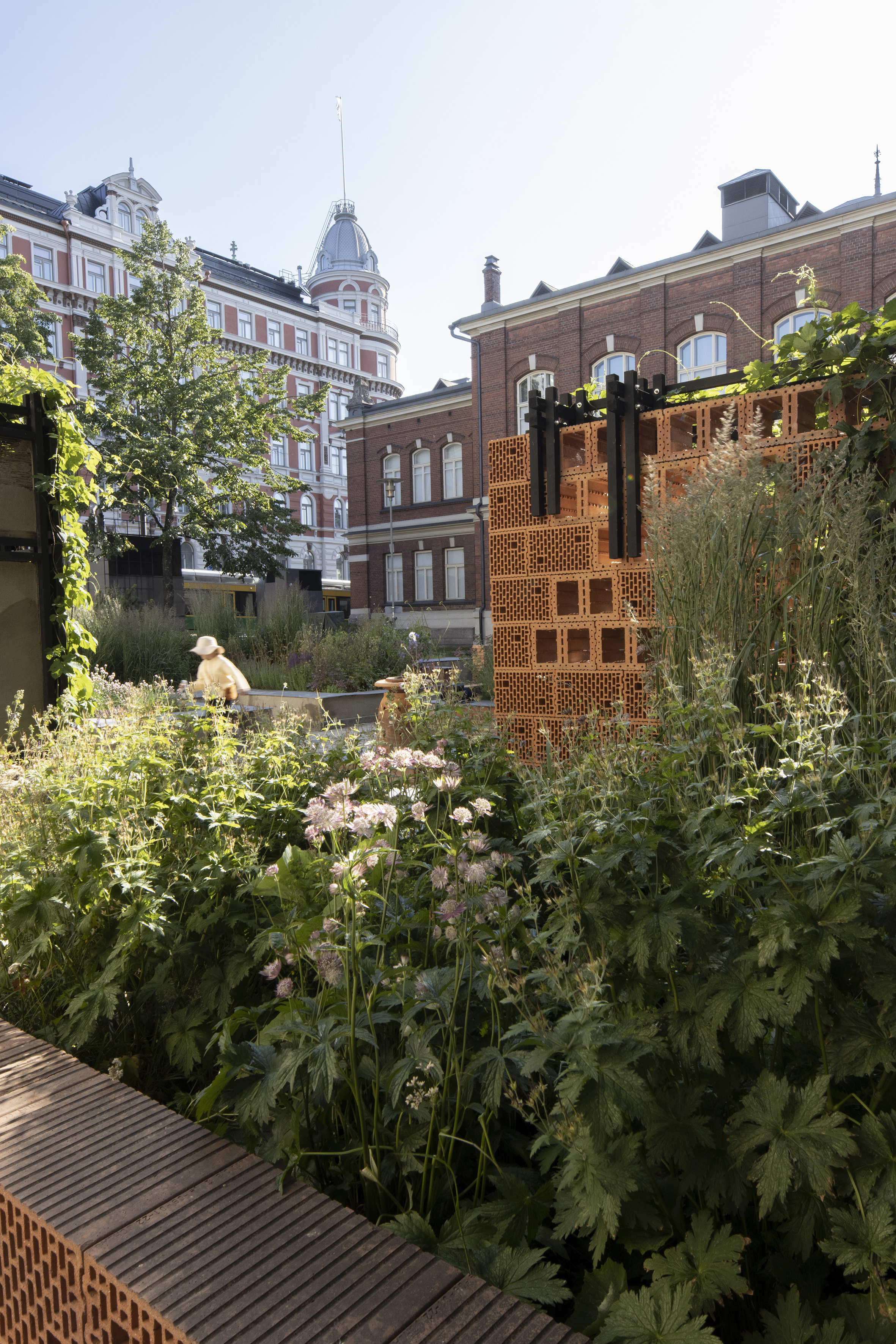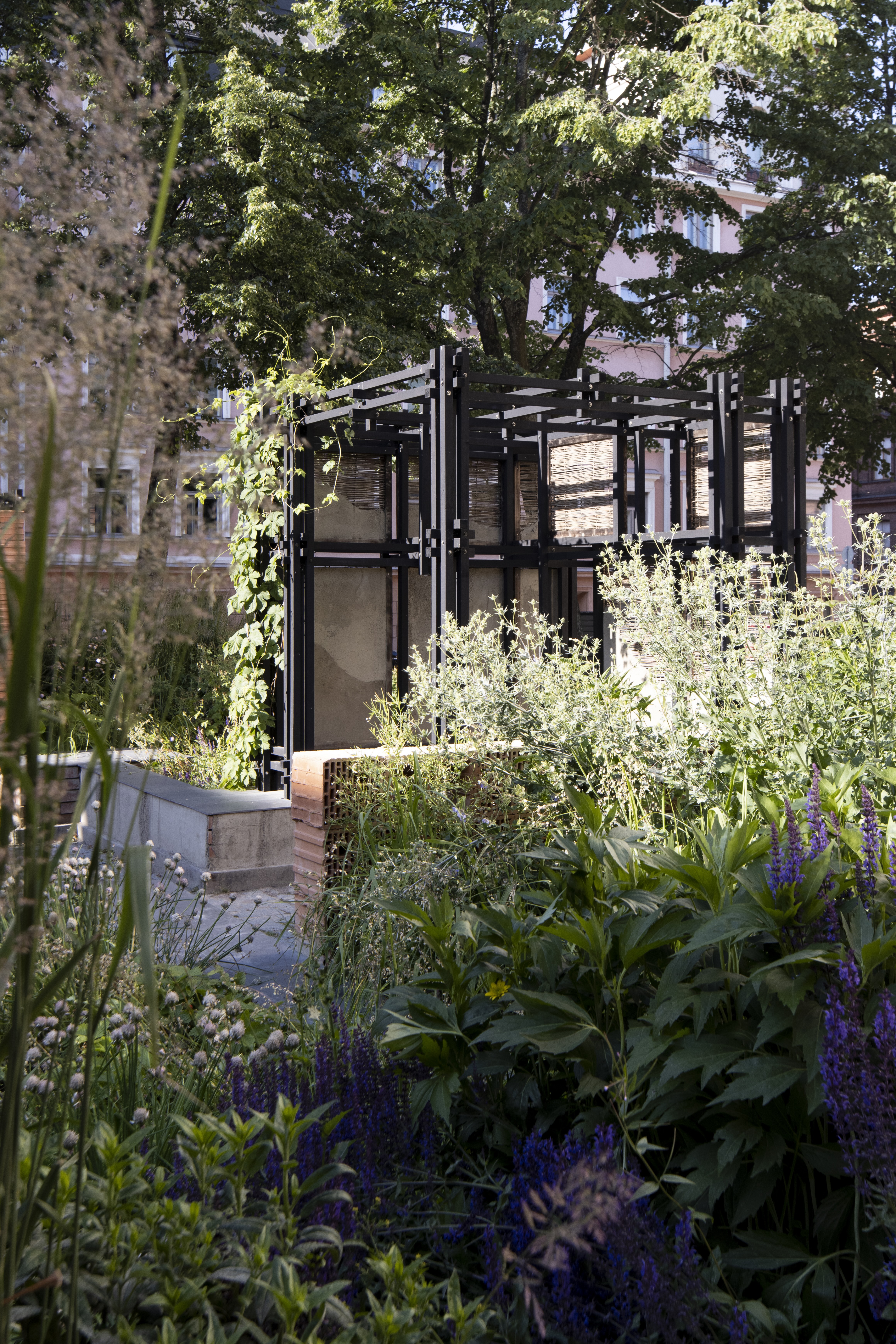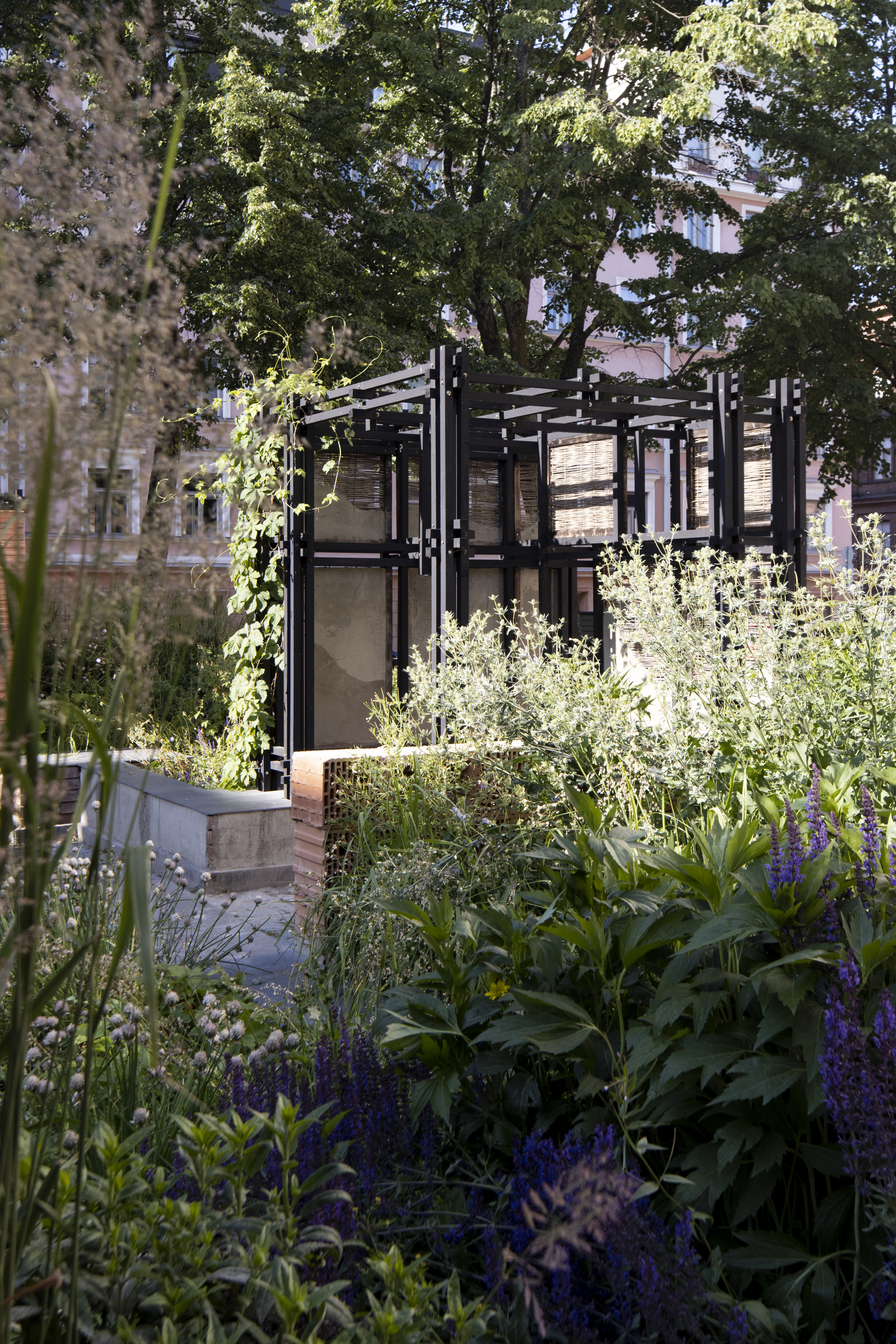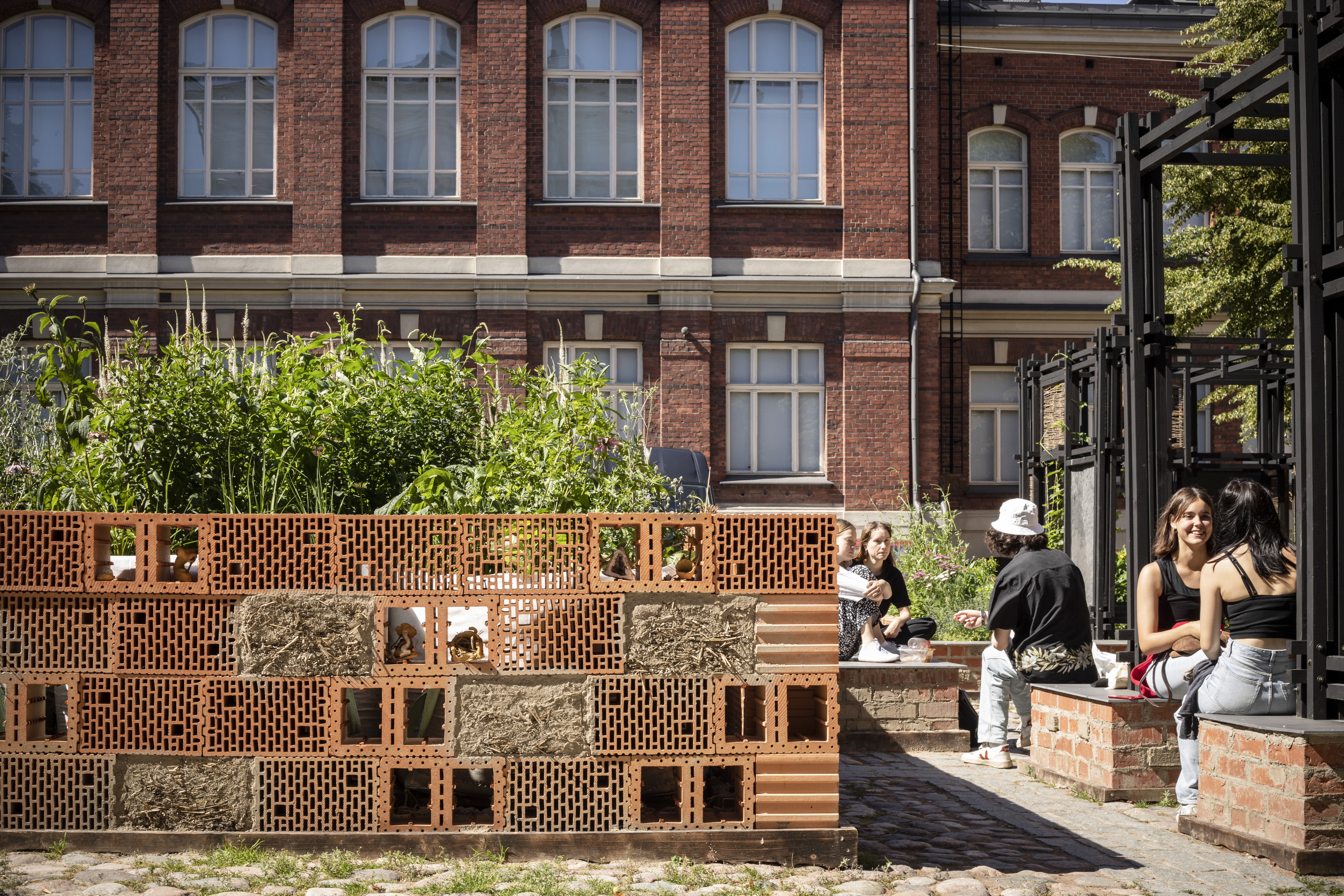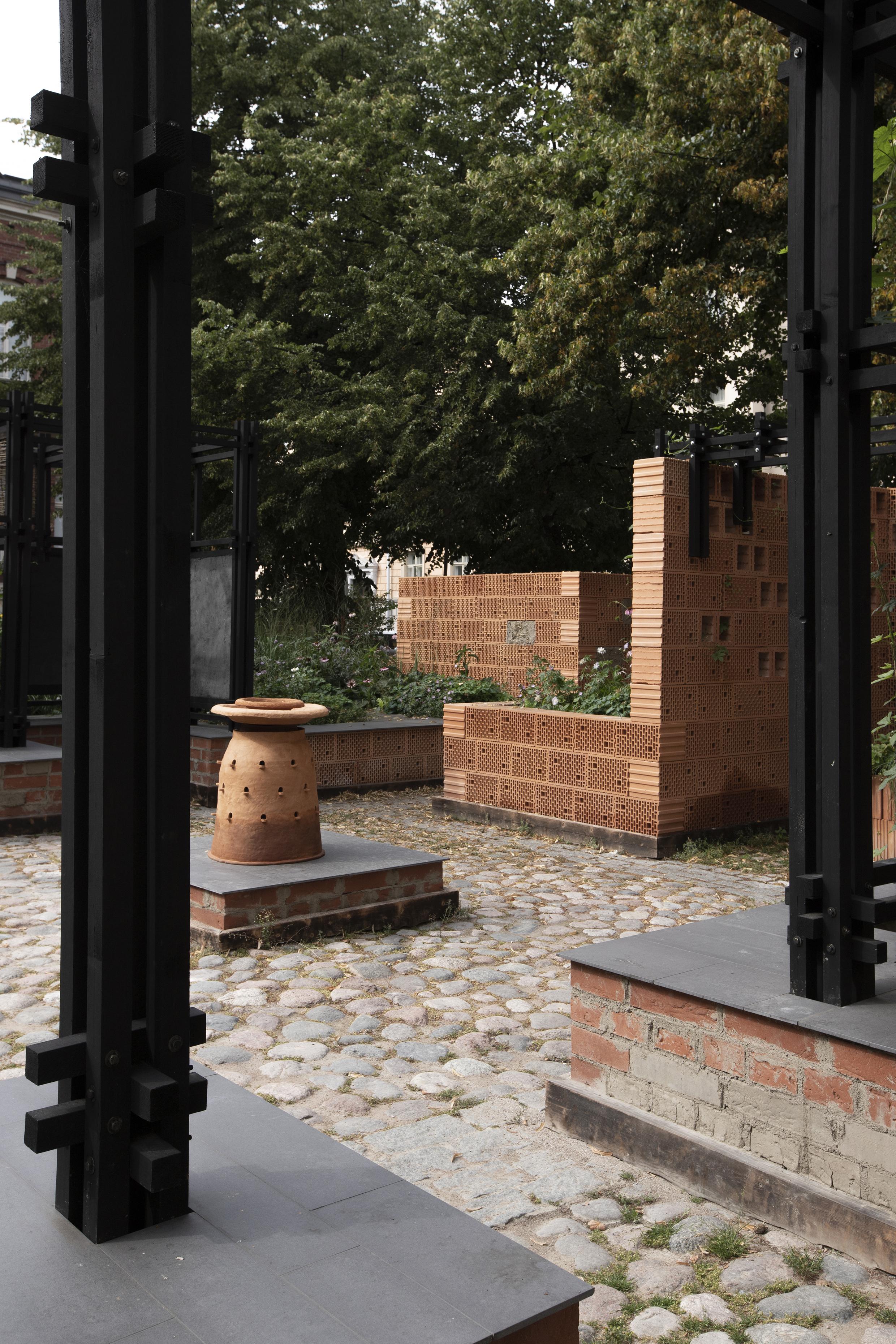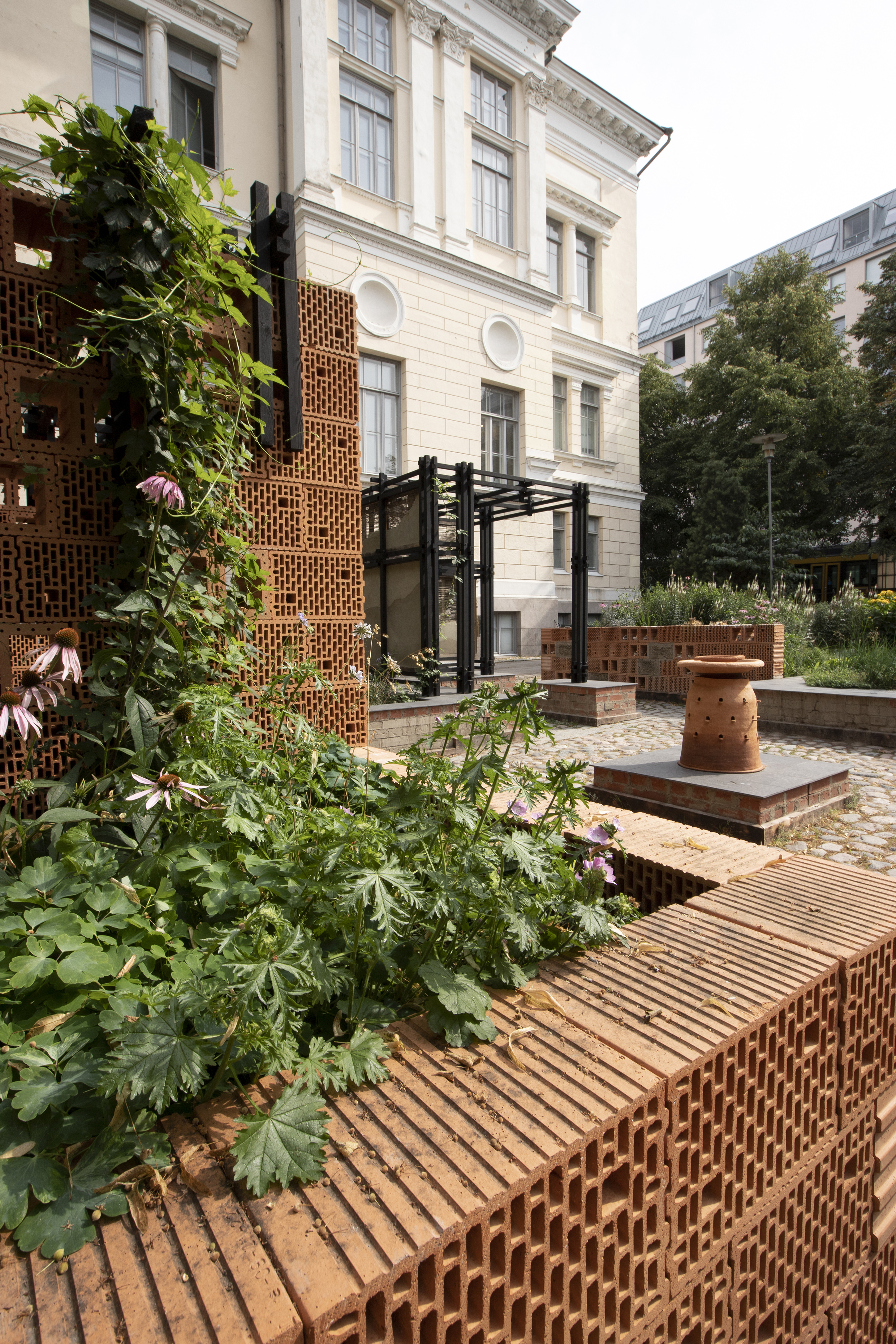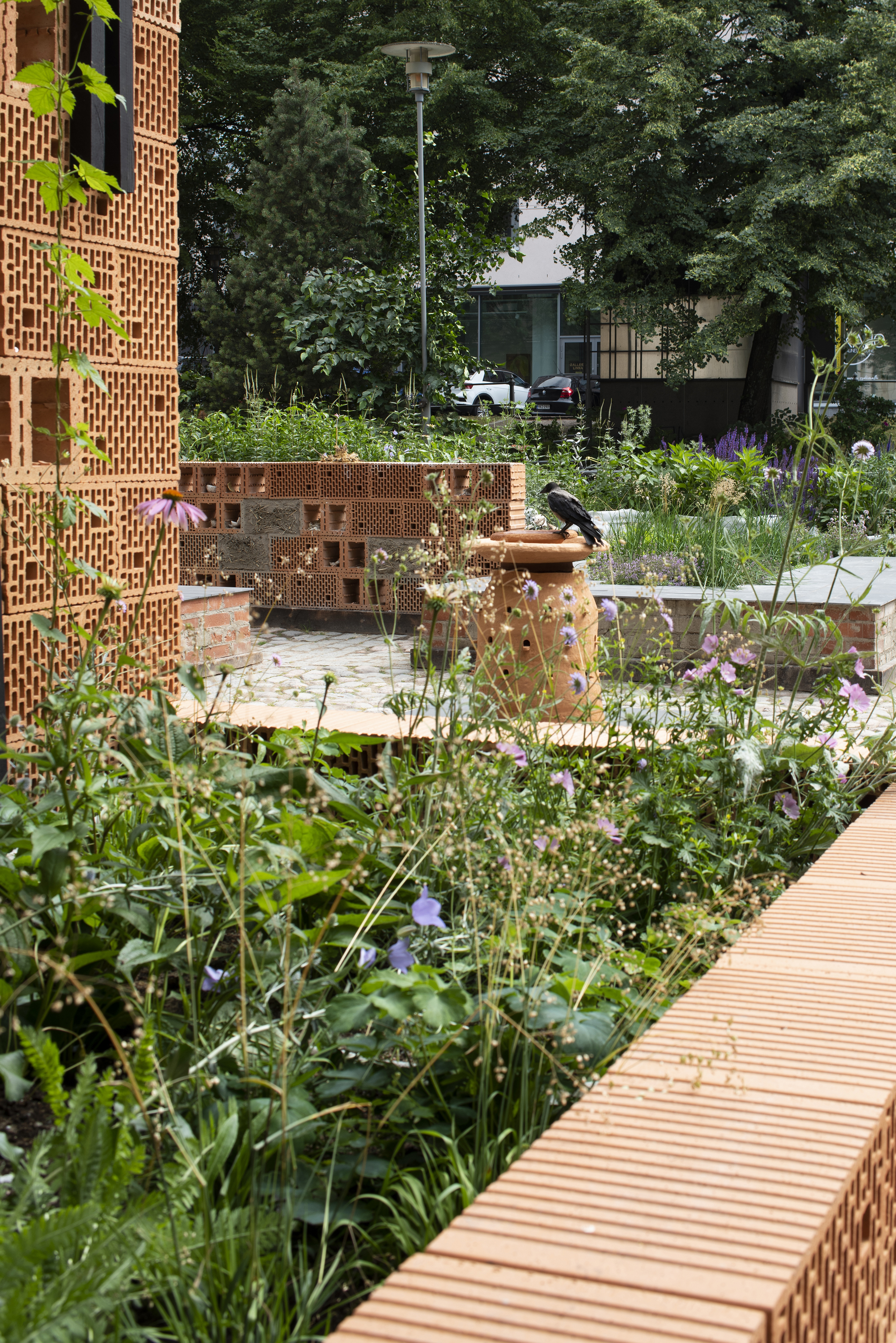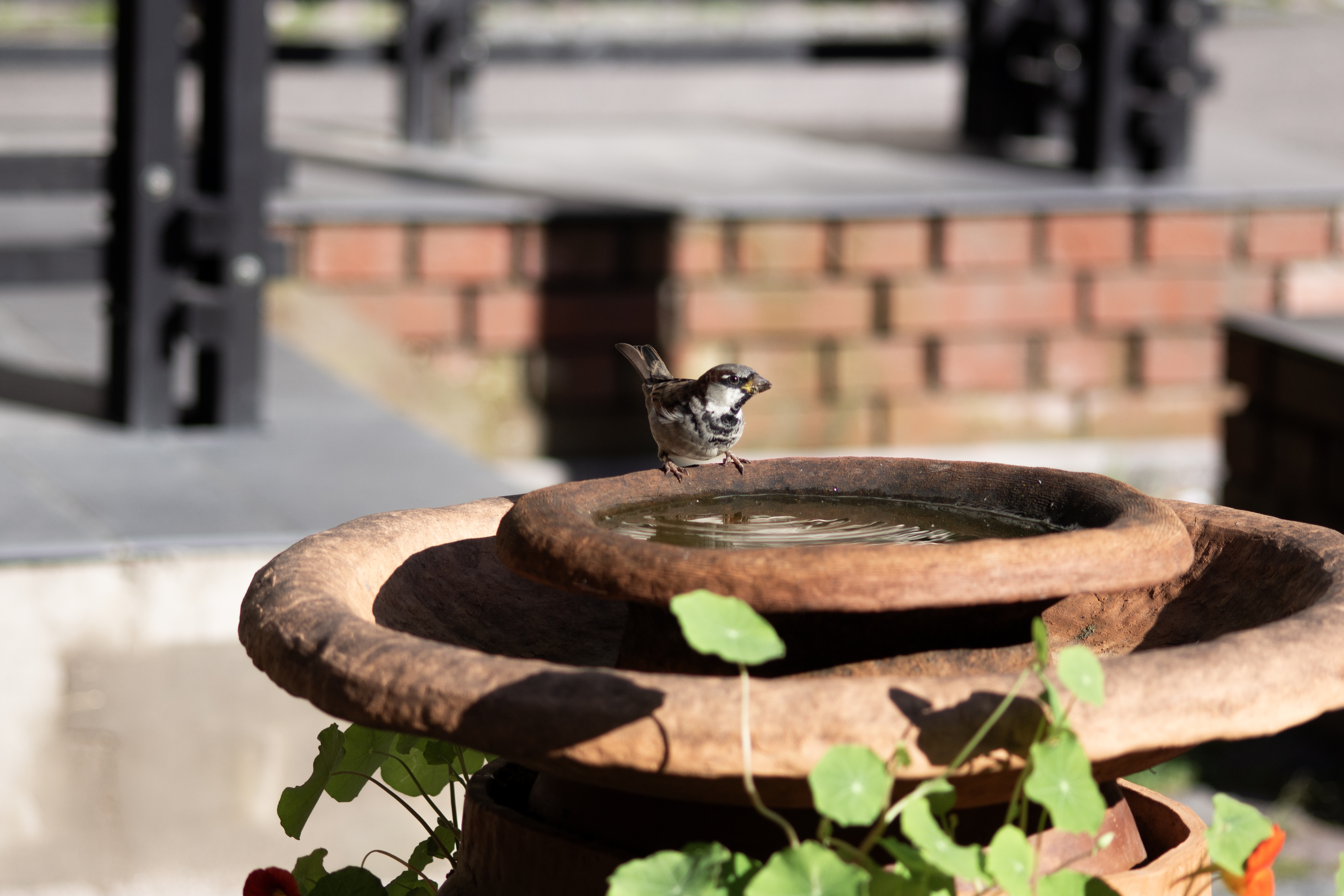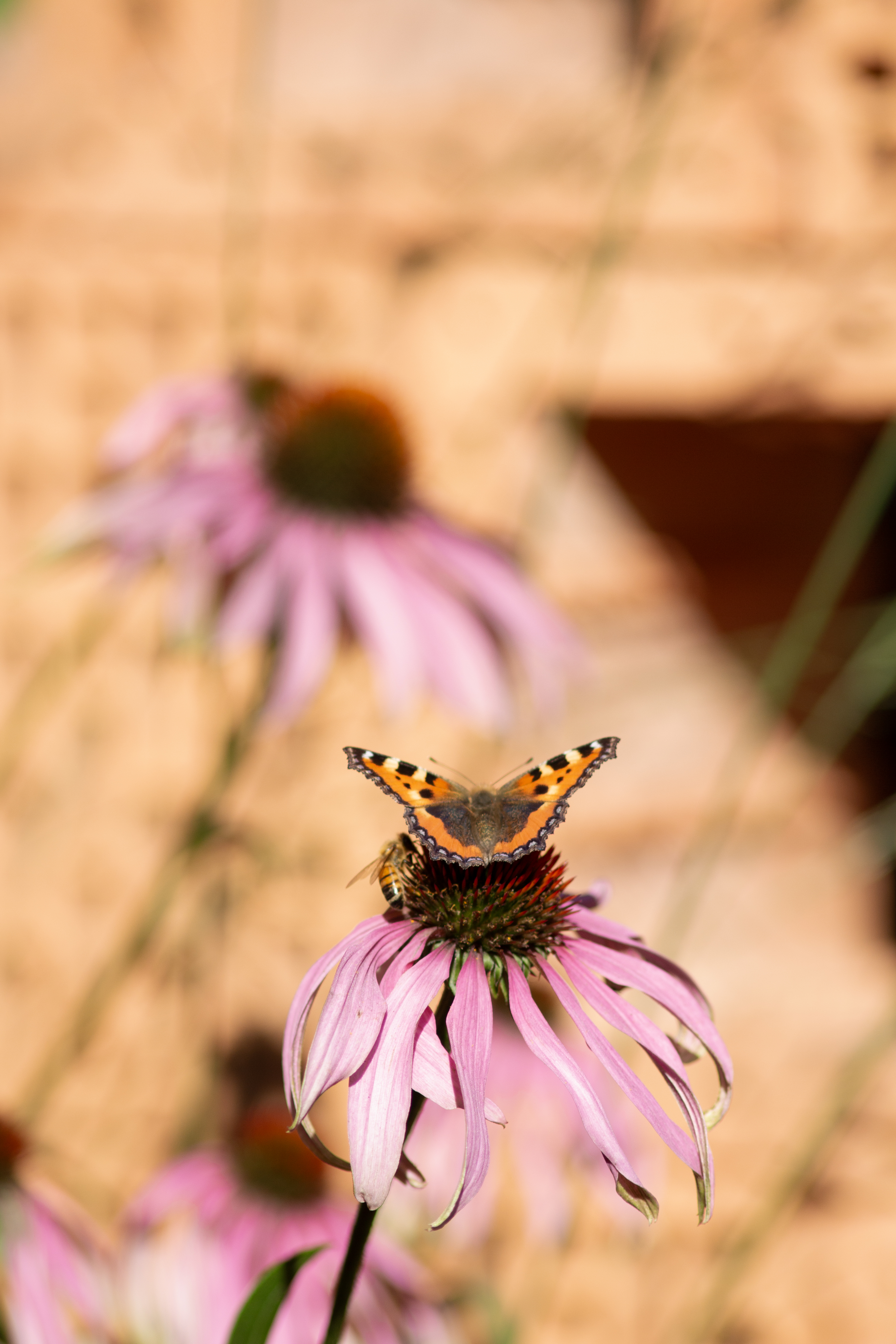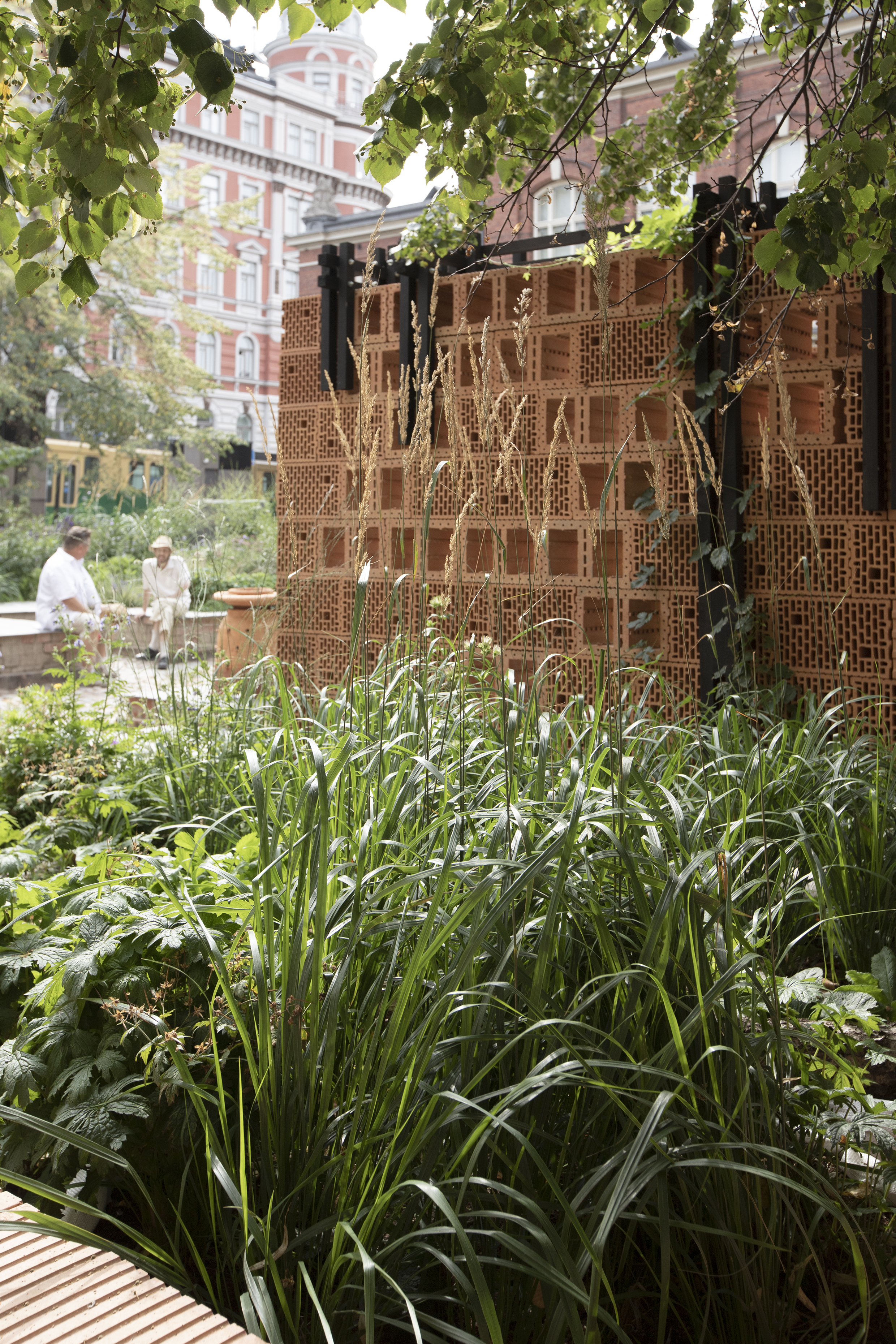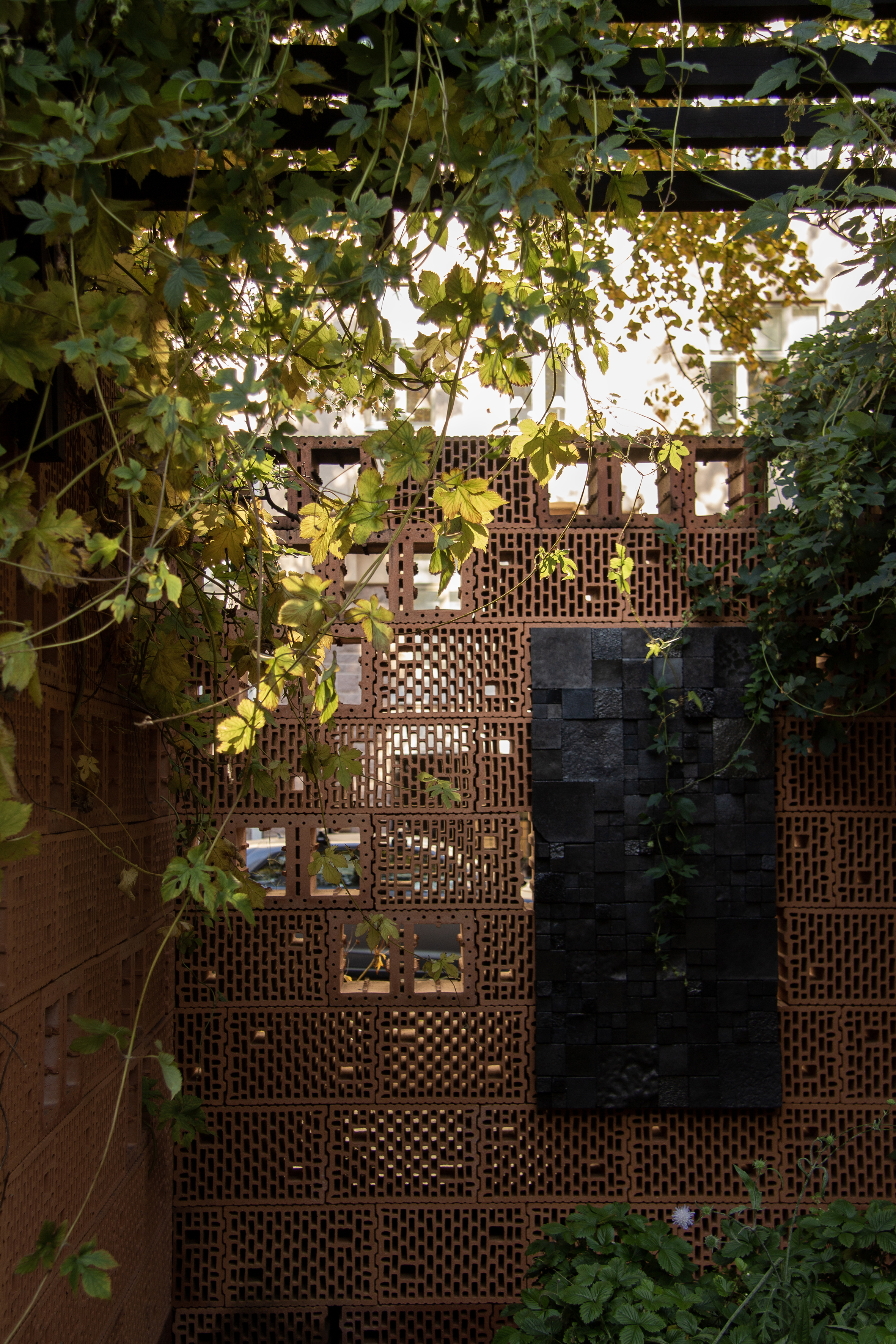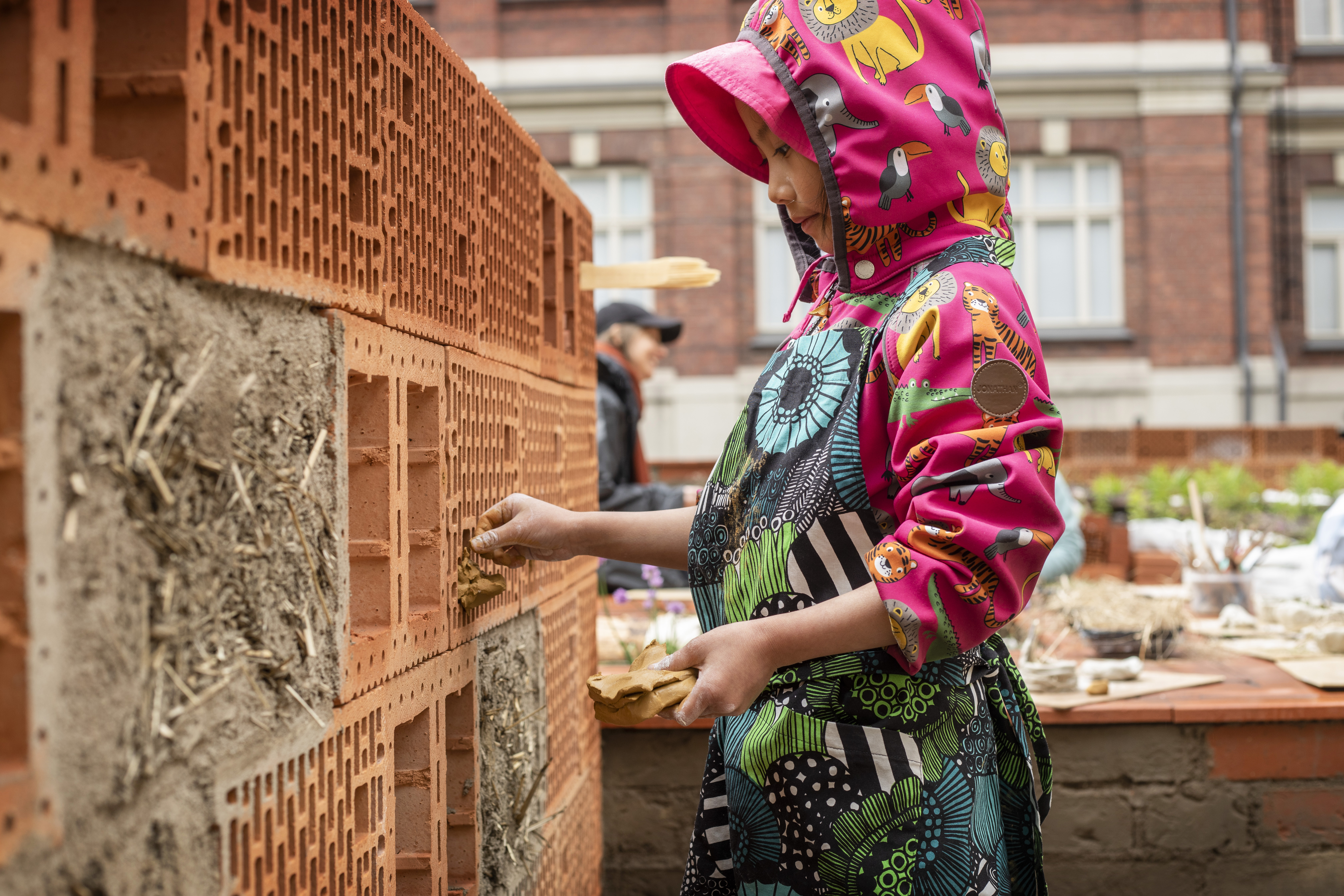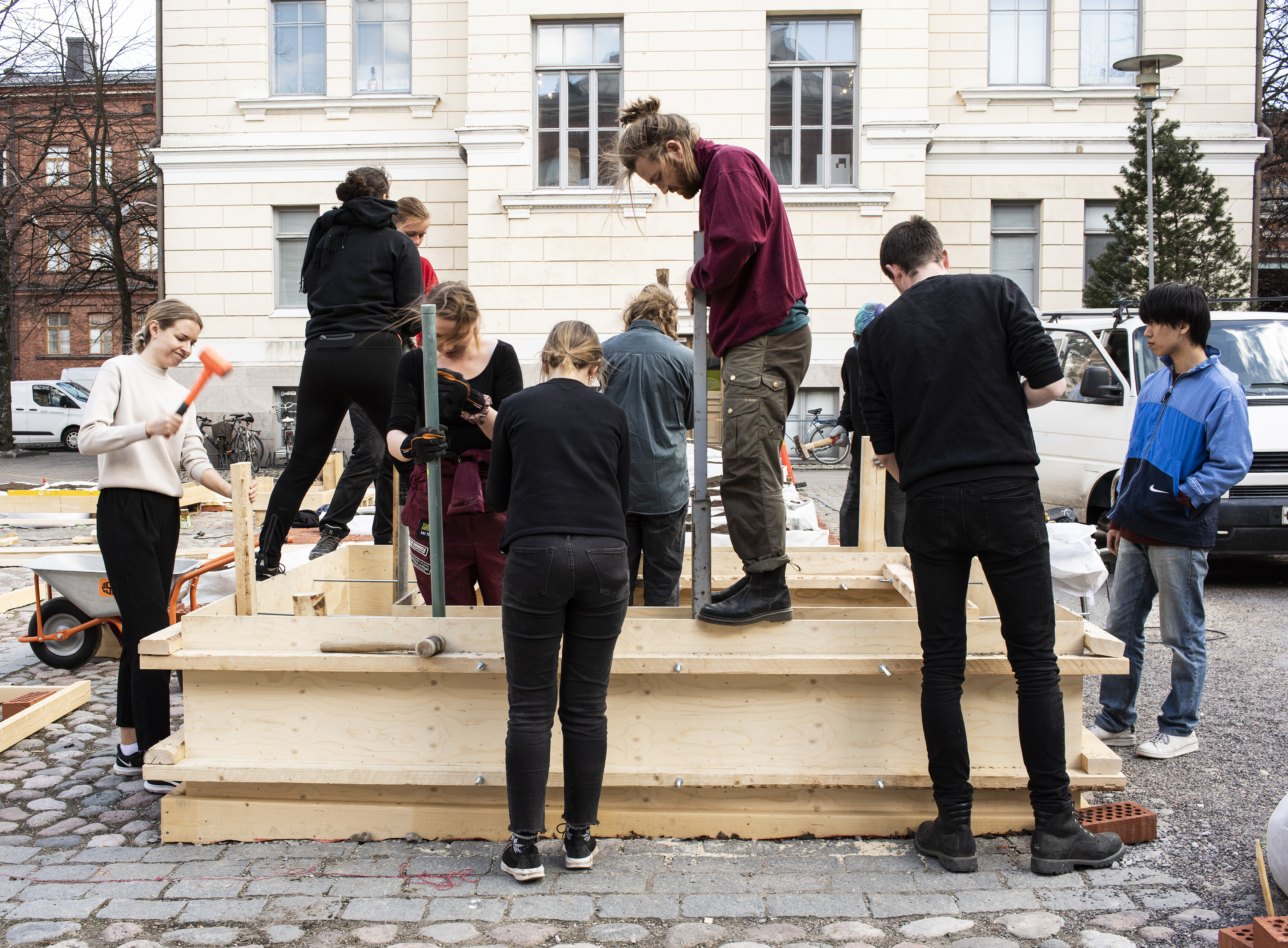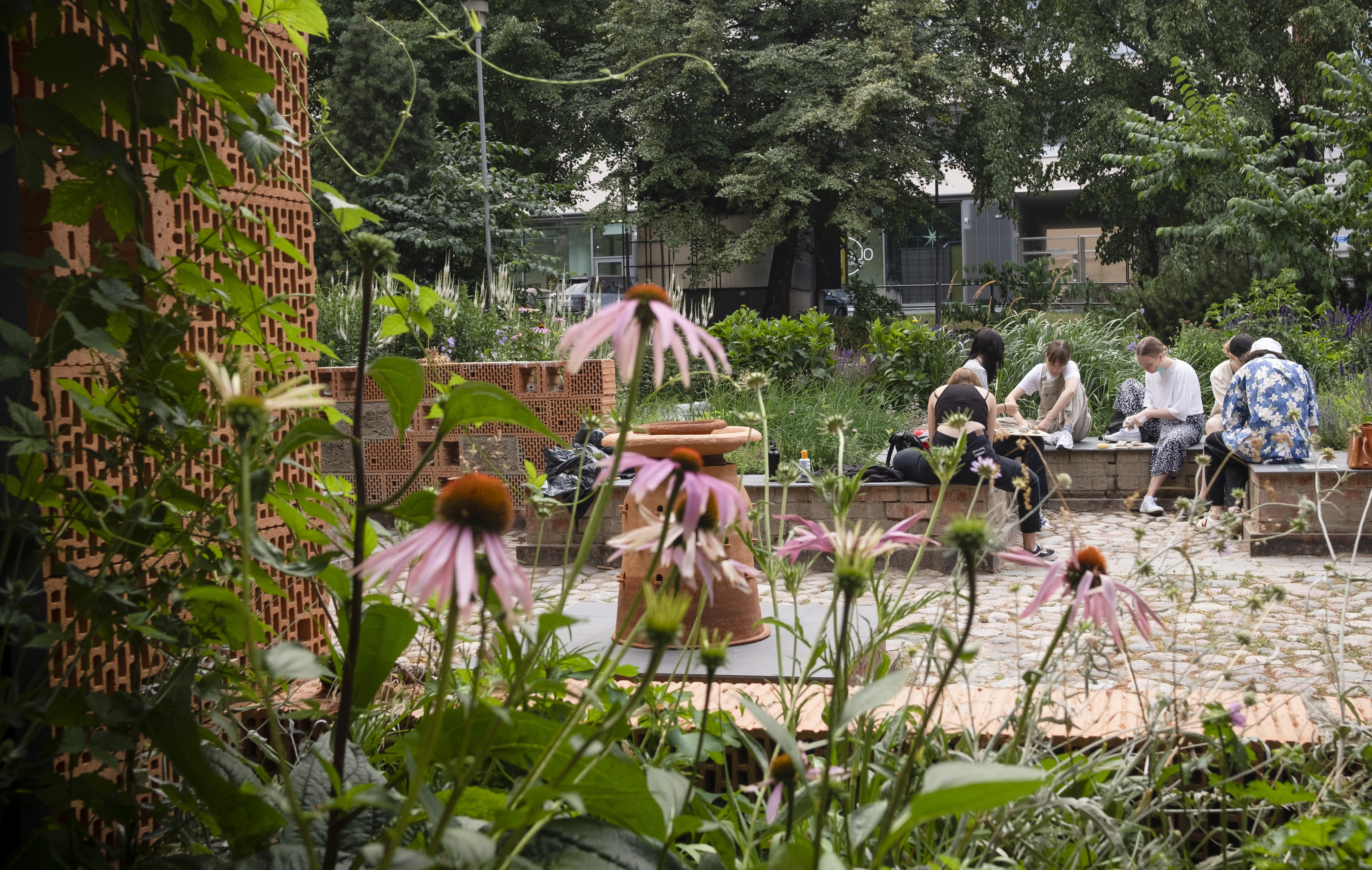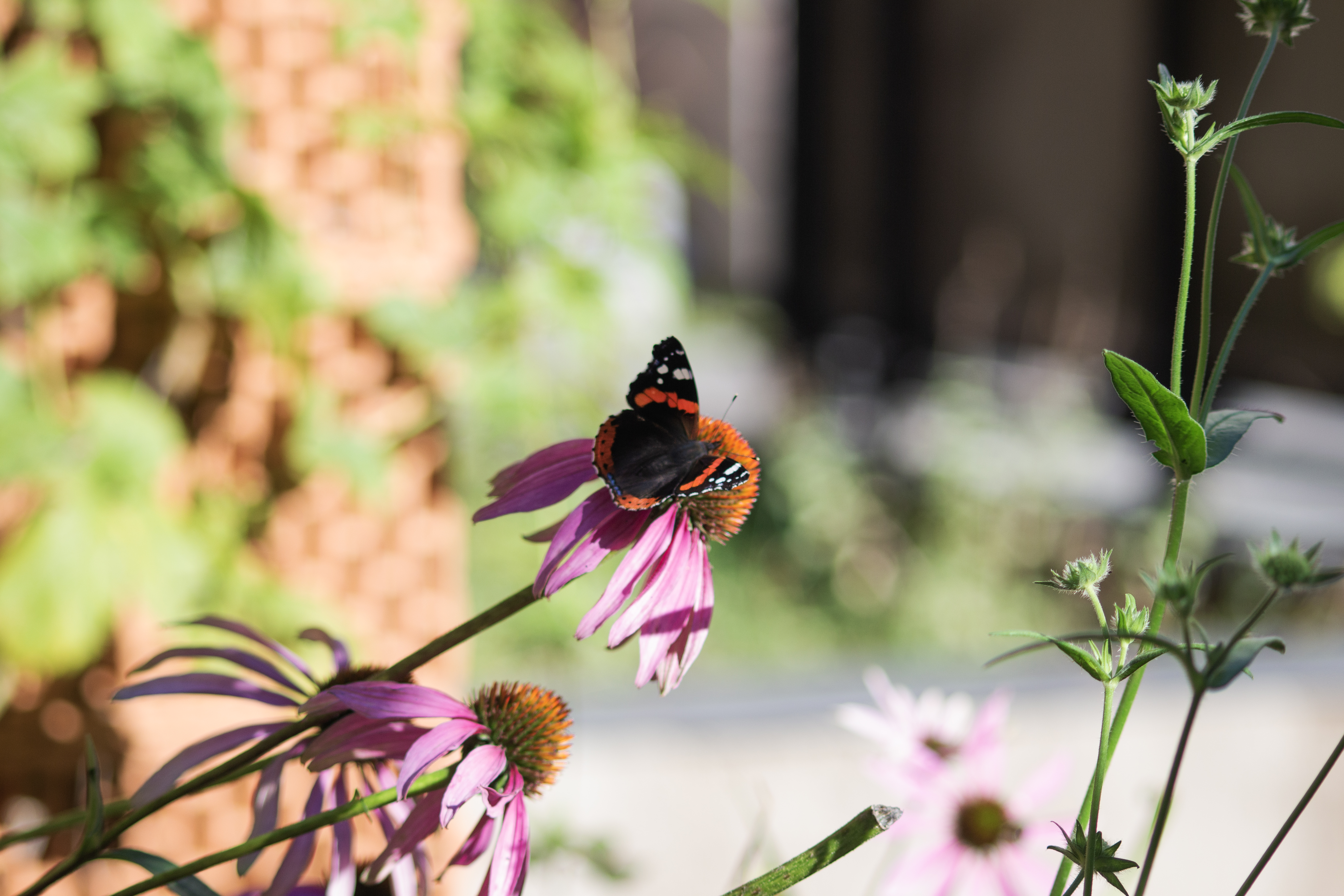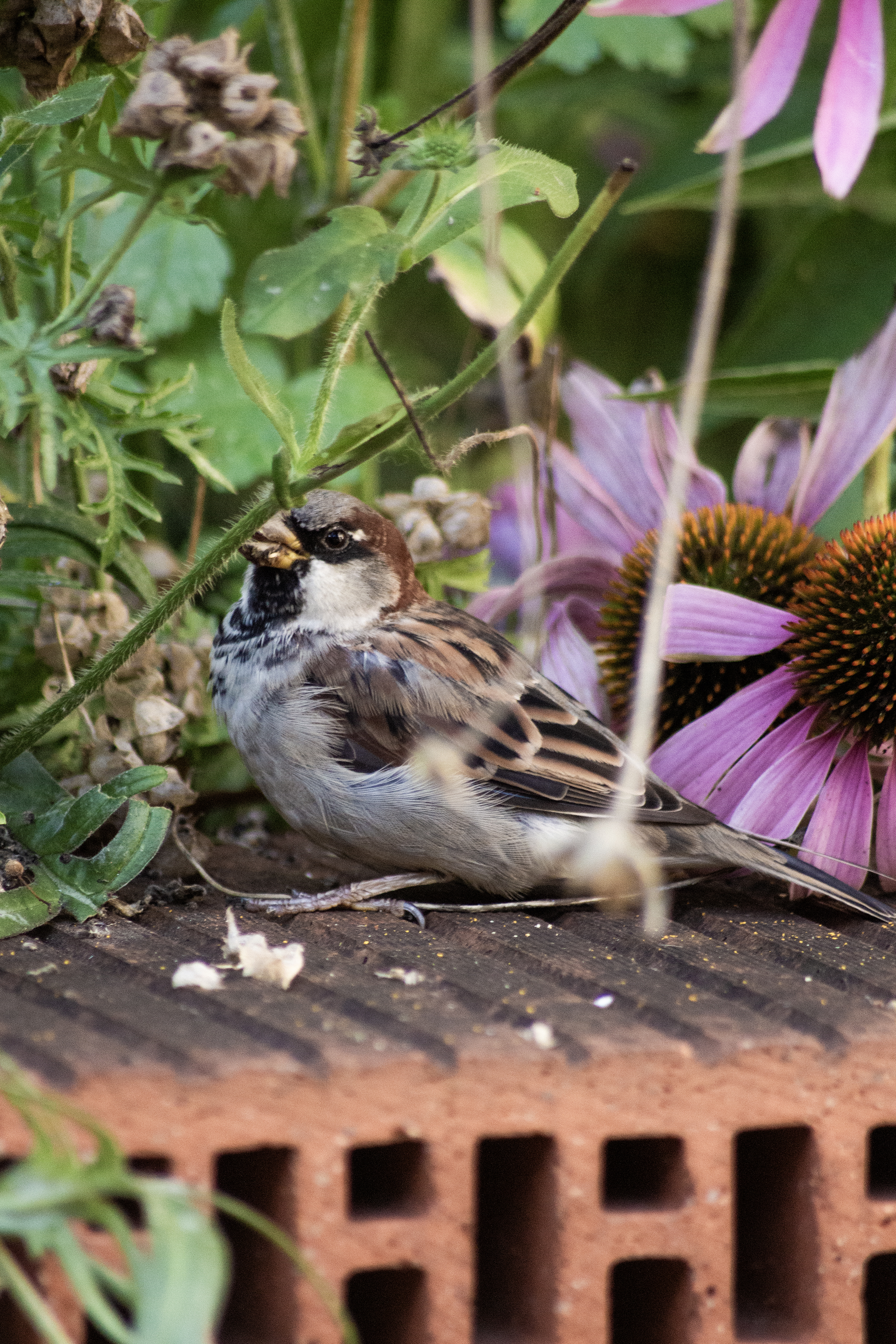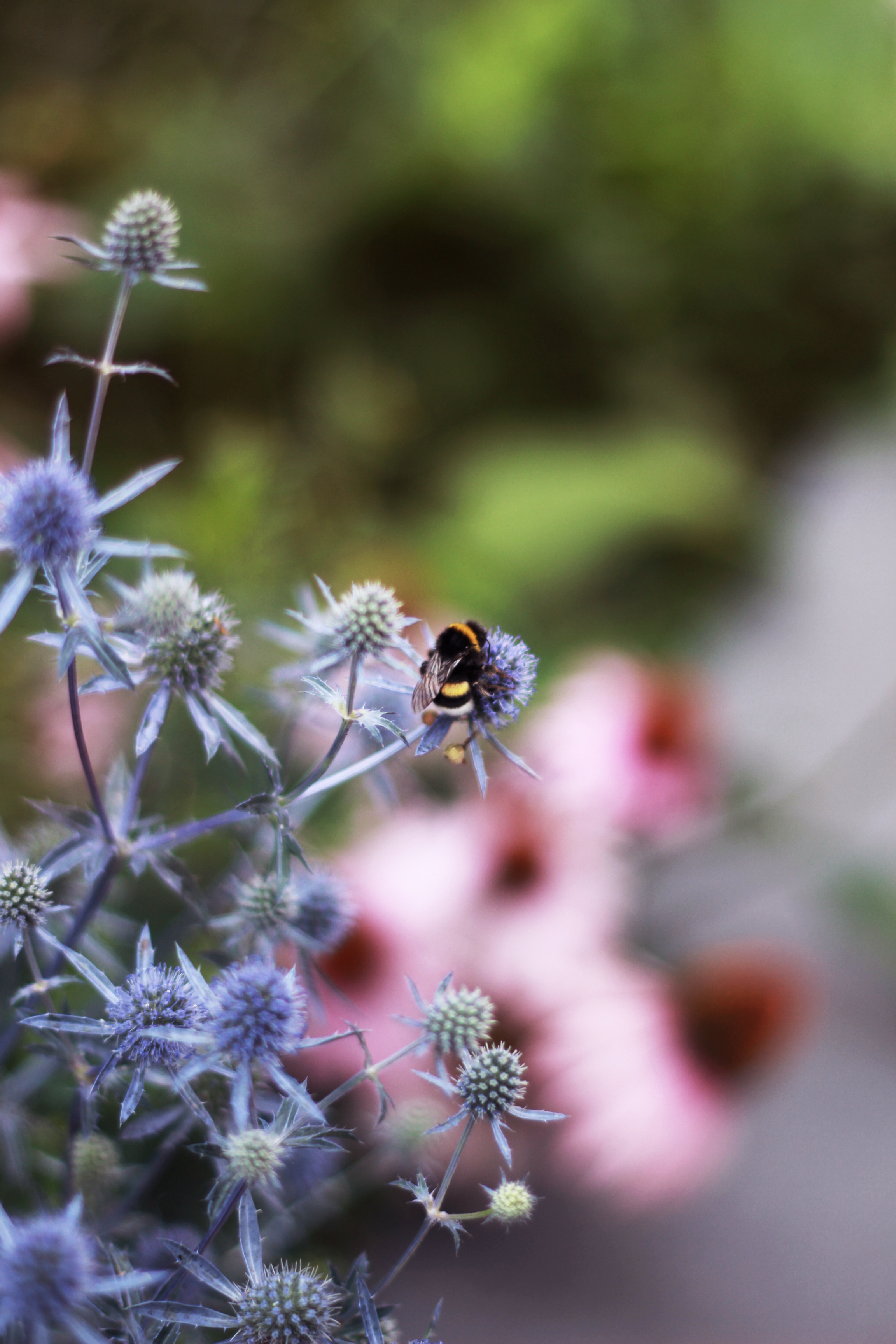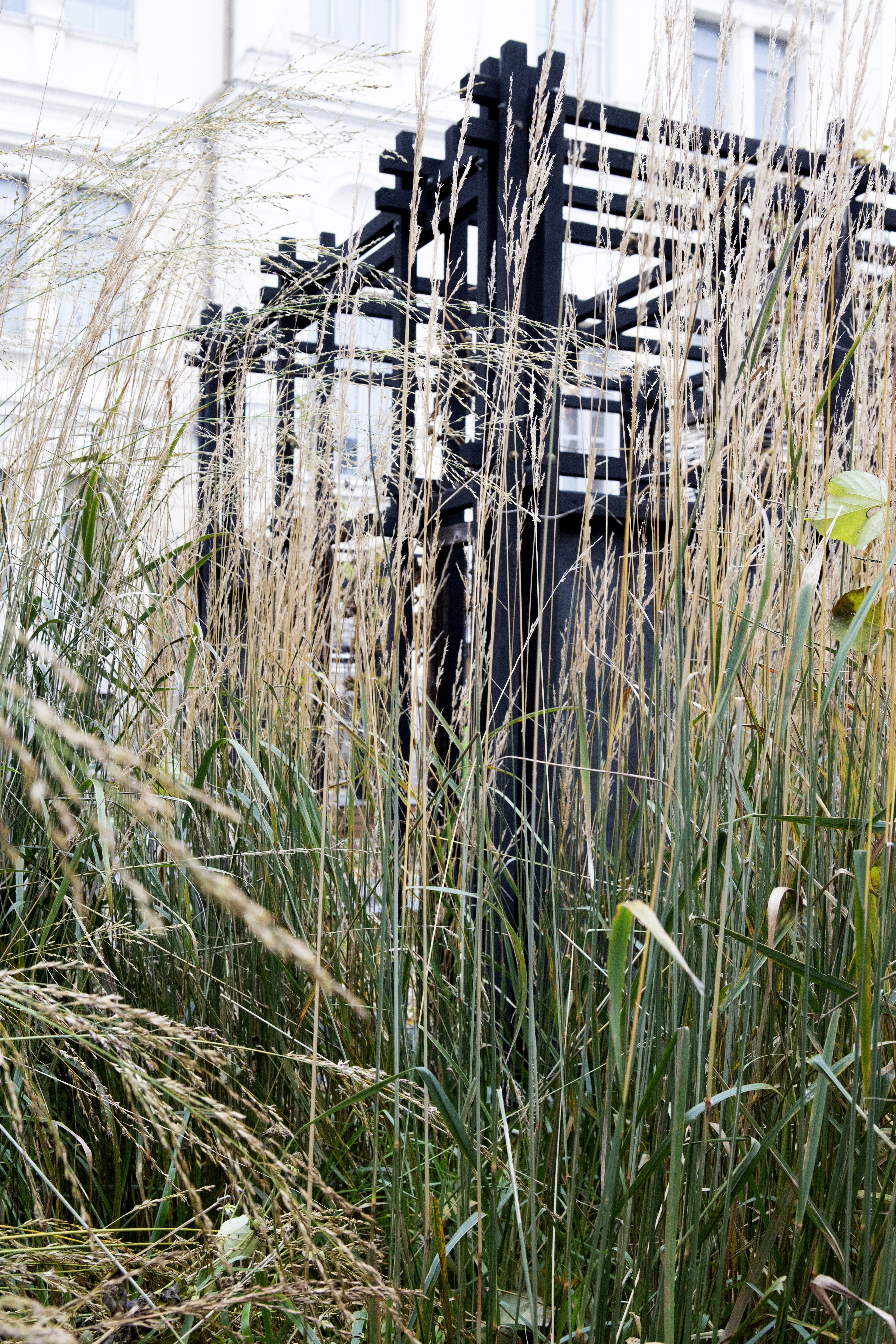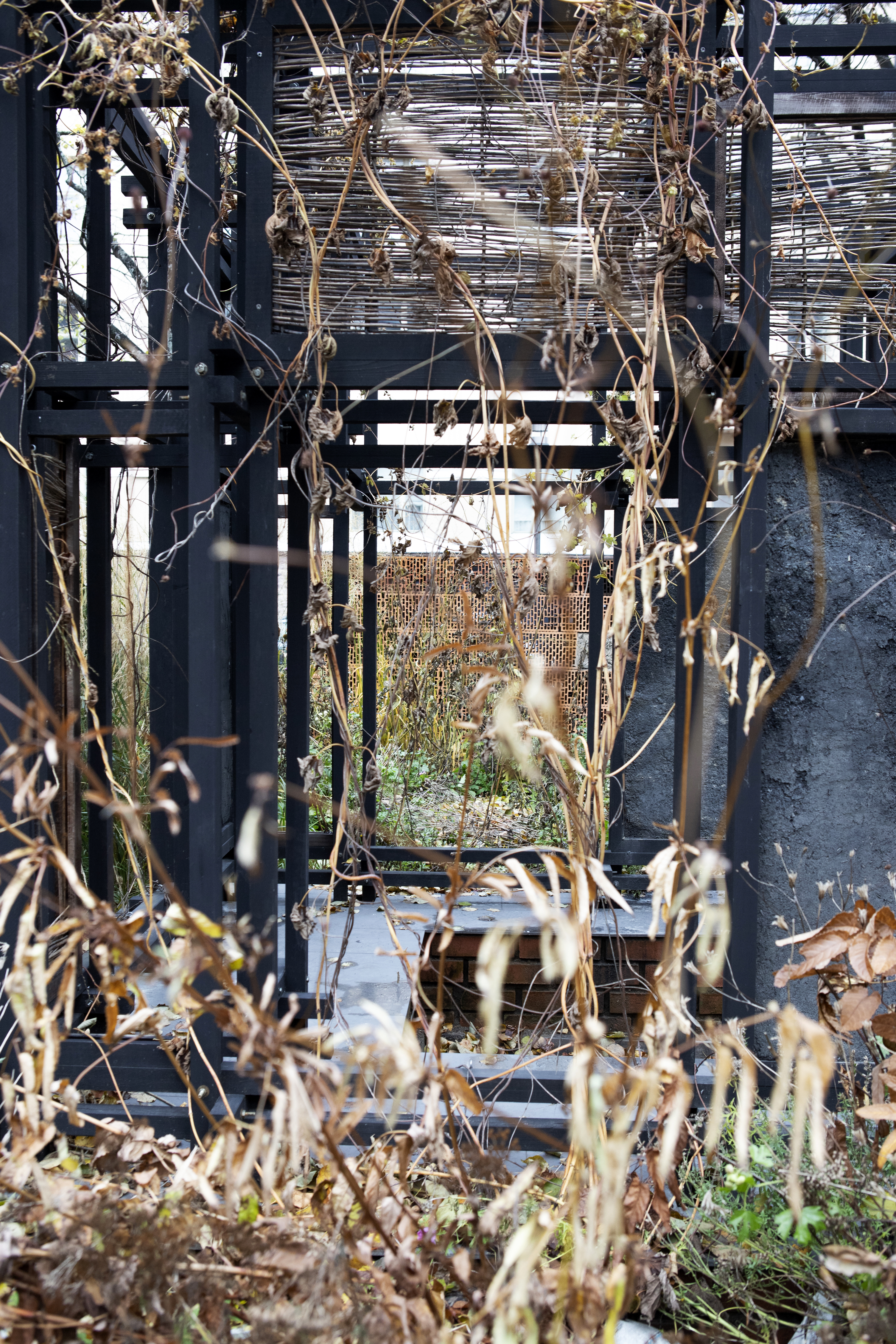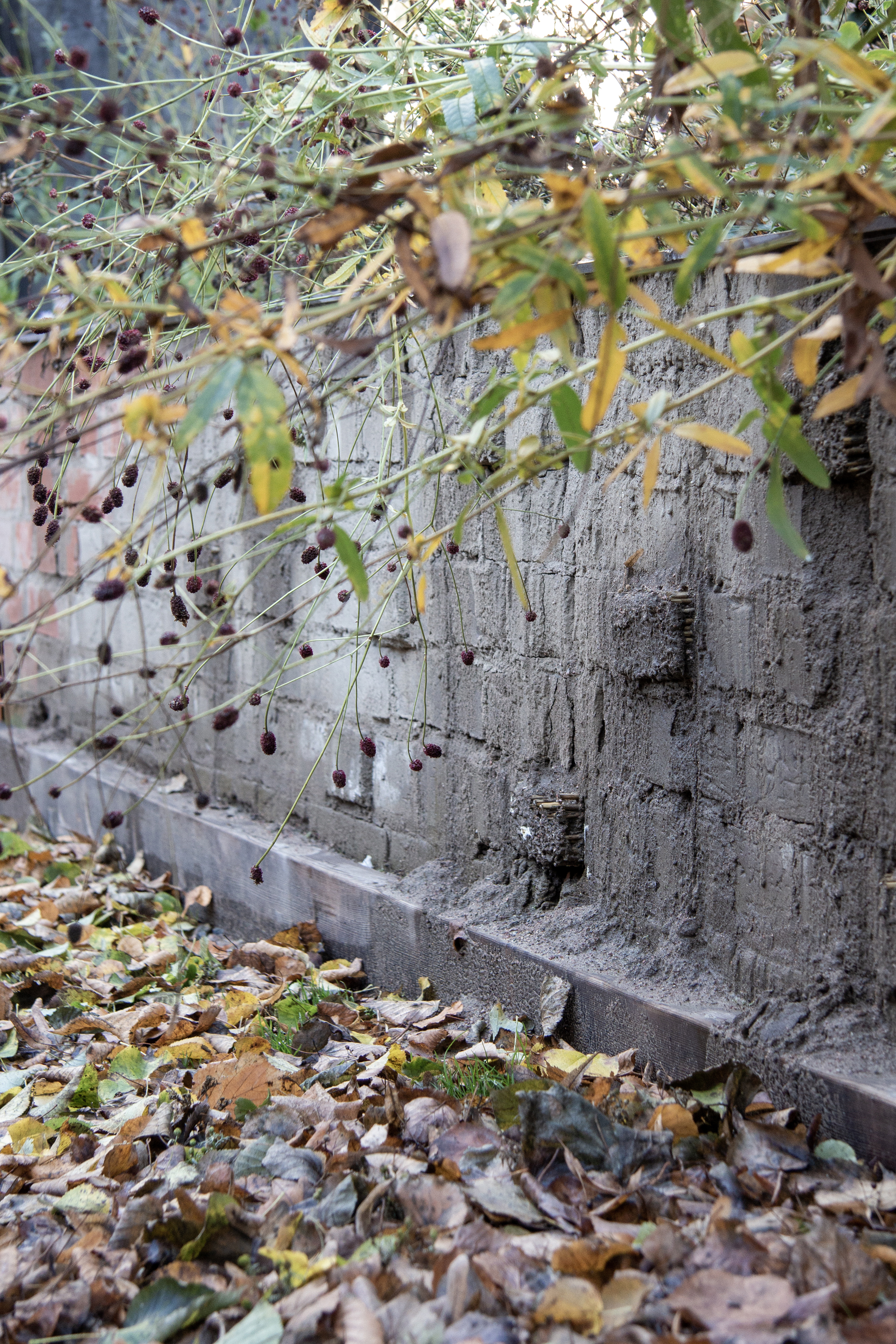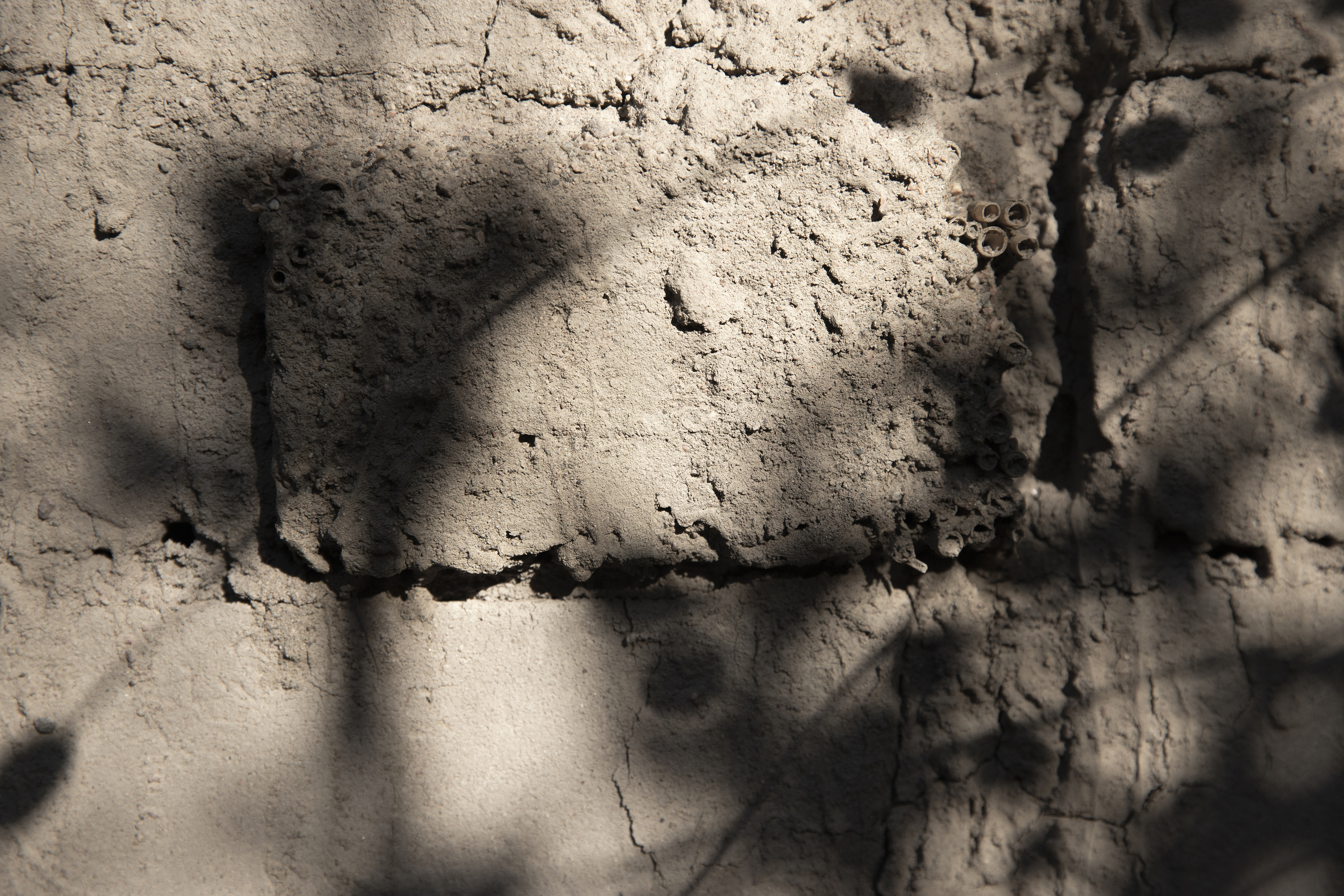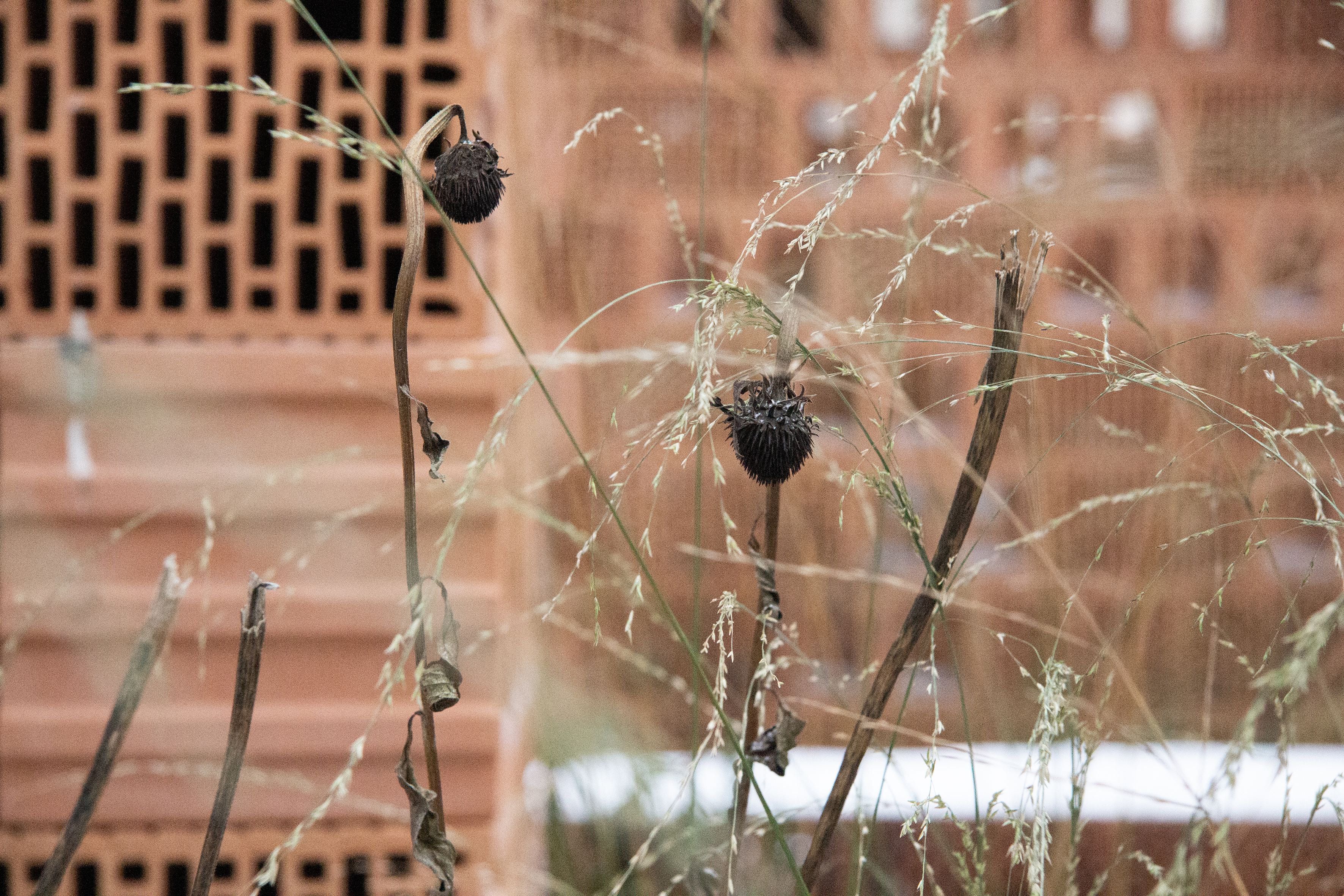Reconnecting with nature
Alusta Pavilion
Alusta Pavilion - Space for Multispecies Encounters and Environmental Discourse
In Alusta pavilion pollinating insects and people can live together in a dense urban setting. Its pollinator-friendly flowers and porous clay structures offer nutrition and shelter for insects and aesthetic enjoyment and wellbeing for people. Its building solutions embody sustainability and circularity throughout their lifecycle. It is a built manifesto of co-existence and care, giving visitors and participants an example of the possibility for change through appealing and replicable solutions.
Finland
National
Mainly urban
It refers to a physical transformation of the built environment (hard investment)
Yes
2022-06-30
No
No
No
As an individual partnership with other persons/organisation(s)
Alusta Pavilion is a space for reconnecting with nature. It is an experimental pavilion project which grew from the initiative of two architects to a diverse community of human and non-human participants. It was first located in Helsinki city center from 2022 until 2024 and then relocated to the Aalto University campus.
In Alusta Pavilion, pollinating insects and people can live together in a dense urban setting. The porous clay structures, decaying wood blocks, and pollinator-friendly flowering perennials offer shelter and nutrition for insects and birds. Fungi and biochar care for the soil and its microbial life which in turn supports plant and animal life, including humans. All this simultaneously promotes human wellbeing and forms a safe and inviting space for all to enjoy.
In the era of the climate crisis and loss of biodiversity, Alusta is a physical example of the possibility for change. It is a venue for learning, and environmental discourse, both through the multisensory material experience, and the activities taking place there. The changing aesthetics, and thriving flowers and butterflies bring people joy. Its building solutions exemplify sustainability and circularity throughout their lifecycle and beyond. Simple construction techniques enable participation of diverse groups of people in the making and caring for the space as well as learning from them. Expert discussions and educational programs held in the space deepen the message. Alusta is simultaneously a practical environmental act and its poetic representation.
Alusta was loved by its human visitors from children to academics resulting in the extension of its life by a year. It was populated by various insect species observed by a pollinator researcher. It affected the microbial life on site enhancing human wellbeing documented by ecology researchers. Its circular solutions were proven successful in the relocation process. It received its first sibling in Kerava in 2024.
In Alusta Pavilion, pollinating insects and people can live together in a dense urban setting. The porous clay structures, decaying wood blocks, and pollinator-friendly flowering perennials offer shelter and nutrition for insects and birds. Fungi and biochar care for the soil and its microbial life which in turn supports plant and animal life, including humans. All this simultaneously promotes human wellbeing and forms a safe and inviting space for all to enjoy.
In the era of the climate crisis and loss of biodiversity, Alusta is a physical example of the possibility for change. It is a venue for learning, and environmental discourse, both through the multisensory material experience, and the activities taking place there. The changing aesthetics, and thriving flowers and butterflies bring people joy. Its building solutions exemplify sustainability and circularity throughout their lifecycle and beyond. Simple construction techniques enable participation of diverse groups of people in the making and caring for the space as well as learning from them. Expert discussions and educational programs held in the space deepen the message. Alusta is simultaneously a practical environmental act and its poetic representation.
Alusta was loved by its human visitors from children to academics resulting in the extension of its life by a year. It was populated by various insect species observed by a pollinator researcher. It affected the microbial life on site enhancing human wellbeing documented by ecology researchers. Its circular solutions were proven successful in the relocation process. It received its first sibling in Kerava in 2024.
biodiversity
environmental discourse
more than human entanglement
circularity
care
Alusta tackles the environmental crisis both on the level of reason and emotion. It is both an environmental act and its symbolic representation. It offers an example of holistic sustainability that increases biodiversity in an urban setting, explores sustainable material solutions and communicates environmentally friendly values and attitudes while creating approachable and enjoyable spatial experiences. On a practical level it is made of materials with low environmental impact, using little fossil energy. On a cultural level Alusta reminds its human visitors that human wellbeing and survival is tied to the wellbeing of the rest of nature. We can no longer treat it as a mere resource. Alusta is built on the intrinsic value of all life. It strives to make visible the natural processes sustaining life, while safeguarding their continuity.
To communicate the interconnectedness of human life with other living beings, Alusta explores the ecological relationality of the soil, plants, pollinators, birds, humans and natural processes of growth and decay. The plants, decaying wood inoculated with fungi, compost soil, clay and biochar structures create wellbeing for people and non-human animals. Raw clay demonstrates possibilities for low energy, low impact construction and material reuse. Biochar elements made of pulp industry’s by-product lignin exemplify material circulation.
Through its aesthetics and location next to the Architecture and Design Museum, Alusta ignites societal discussion and change. The museum context allows Alusta to reach the public and design professionals to rethink our culture’s relationship with nature. The open, free public space allows different people to engage with it. Alusta binds together sustainable architectural education and interdisciplinary collaboration. Educational and recreational programs in the space open questions of sustainable land and material use, creative ecologies and interbeing. Media presence reinforces the impact.
To communicate the interconnectedness of human life with other living beings, Alusta explores the ecological relationality of the soil, plants, pollinators, birds, humans and natural processes of growth and decay. The plants, decaying wood inoculated with fungi, compost soil, clay and biochar structures create wellbeing for people and non-human animals. Raw clay demonstrates possibilities for low energy, low impact construction and material reuse. Biochar elements made of pulp industry’s by-product lignin exemplify material circulation.
Through its aesthetics and location next to the Architecture and Design Museum, Alusta ignites societal discussion and change. The museum context allows Alusta to reach the public and design professionals to rethink our culture’s relationship with nature. The open, free public space allows different people to engage with it. Alusta binds together sustainable architectural education and interdisciplinary collaboration. Educational and recreational programs in the space open questions of sustainable land and material use, creative ecologies and interbeing. Media presence reinforces the impact.
Alusta was created as a place for experiencing nature and its interconnectedness in an urban setting where there is normally little or no contact with nature. The designers hoped to create a calm space for humans to resensitize to the different ways of existence of the nonhuman, to attune to their pace and let their ways of being alive open in and around them. The space was intended as a vehicle for these encounters and the re-evaluation of our culture’s relationship with nature.
Rethinking one's worldview and values requires a sense of safety and comfort. Alusta was designed to create wellbeing for humans through taking into account their physical and psychological health. Simultaneously ecological interventions were planned to invite nonhuman animals to enjoy the space. To create an example of shared wellbeing, all design decisions were made considering the needs of both. Porous clay and biochar structures open passages and nesting space for insects. Their haptic materiality forms an interesting spatial experience for humans awakening the sense of touch. Flowering perennials offer nourishment for pollinators and sensory joys for people.
In Alusta, the embodied aesthetic experience of space opens through emotions in time. Sustainability is approached on the level of the imagination and creativity as well as through facts. The continuous aesthetic transformation of the space is tied to the cyclic rhythms of the more than human world. Clay erodes with water and time, plants grow, bloom and wither, fungi, algae, lichen, and moss begin to take over as time passes and moisture takes hold. Attention is guided towards other than human timescapes which sustain the liveability of the planet. Gradual changes, often too slow for human senses to observe, are enforced and made accessible for human experience. Creative ownership of the space is shared with the plants and the natural processes as nature is given an active voice in shaping the space.
Rethinking one's worldview and values requires a sense of safety and comfort. Alusta was designed to create wellbeing for humans through taking into account their physical and psychological health. Simultaneously ecological interventions were planned to invite nonhuman animals to enjoy the space. To create an example of shared wellbeing, all design decisions were made considering the needs of both. Porous clay and biochar structures open passages and nesting space for insects. Their haptic materiality forms an interesting spatial experience for humans awakening the sense of touch. Flowering perennials offer nourishment for pollinators and sensory joys for people.
In Alusta, the embodied aesthetic experience of space opens through emotions in time. Sustainability is approached on the level of the imagination and creativity as well as through facts. The continuous aesthetic transformation of the space is tied to the cyclic rhythms of the more than human world. Clay erodes with water and time, plants grow, bloom and wither, fungi, algae, lichen, and moss begin to take over as time passes and moisture takes hold. Attention is guided towards other than human timescapes which sustain the liveability of the planet. Gradual changes, often too slow for human senses to observe, are enforced and made accessible for human experience. Creative ownership of the space is shared with the plants and the natural processes as nature is given an active voice in shaping the space.
“Alusta” in the Finnish language signifies both ‘a platform’ and ‘to begin anew’. As a project Alusta questions existing environmentally and socially detrimental practices and strives to create positive alternatives. It is a public space accessible for all, open and free. Located between two Helsinki museums in the heart of the city, it offers a respite from urban commercial spaces and allows for anyone to come and use it as they wish. It is a sanctuary for people, pollinating insects and birds. There is sensory enjoyment and a calm atmosphere for anyone, as well as nutrition, shelter and water for the non-human visitors. Bringing non-human nature into the city promotes equality as not everyone is physically able or can afford to travel to the wilderness and the wellbeing effects of non-human nature to humans are well known. Alusta is an example of what non-consumerist attractions in the city could mean.
The process of making Alusta was based on multidisciplinary collaboration and educational possibilities. The chosen techniques allowed for working with clay construction students and architectural students and offered learning opportunities lacking from the study programs at their respective institutions. Simple techniques made it possible to open the construction process also for the local community. Information on sustainable construction methods was shared e.g. in workshops making and mending raw clay structures. These affordable simple techniques offer empowerment and enable replicating them regardless of economic or societal background. Making together became a way of establishing community and means of alternative value-creation. A sense of connectedness and well-being not tied to monetary value arose, thus combating the idea of buildings as commercial commodities.
The cultural program is also free and open for all. The message of Alusta opens on different levels to different people from enjoying the butterflies to listening to academic discussions.
The process of making Alusta was based on multidisciplinary collaboration and educational possibilities. The chosen techniques allowed for working with clay construction students and architectural students and offered learning opportunities lacking from the study programs at their respective institutions. Simple techniques made it possible to open the construction process also for the local community. Information on sustainable construction methods was shared e.g. in workshops making and mending raw clay structures. These affordable simple techniques offer empowerment and enable replicating them regardless of economic or societal background. Making together became a way of establishing community and means of alternative value-creation. A sense of connectedness and well-being not tied to monetary value arose, thus combating the idea of buildings as commercial commodities.
The cultural program is also free and open for all. The message of Alusta opens on different levels to different people from enjoying the butterflies to listening to academic discussions.
Citizens took part in the construction of Alusta and learned about the material and immaterial methods used through many open clay building and planting workshops. Participants learned e.g. how to transform their outdoor areas to pollinator friendly ones, and how to use clay in homes and gardens. Residents of a neighboring building took part in bokashi-composting creating soil for the plant community. As a permanent result a bokashi system was established in the building.
During years 2022-2024 a wide range of program took place at Alusta; construction workshops for students, nest building clay workshops of environmental thinking for families with young children, the results of which remain as part of the pavilion, sustainable architecture summer schools for high school students, school and kindergarten visits for different agegroups. Lecture and discussion program for both design professionals and general public is described later. Concerts and a movie screening also took place.
The themes of the project have been communicated to different audiences of citizens and experts through media appearances both nationally and internationally. The designers have visited e.g. the morning TV show of the Finnish national broadcasting company YLE with 250 000 daily viewers and the day radio program with 1 million daily listeners. Professional audiences have been reached through publications such as Archdaily, Dezeen and the Finnish Architectural Review. The academic community is engaged through Suomi’s doctoral research articles, Suomi and Koivisto’s teaching as well as various presentations and articles. Alusta was also part of the program of Helsinki Design Week and Aalto University's Designs for a Cooler Planet exhibition in 2022-2024.
Spontaneous visits of citizens activate the embodied experiences of reconnecting with nature in an urban environment. The appreciation of human visitors resulted in the extension of Alusta’s life from two to three years.
During years 2022-2024 a wide range of program took place at Alusta; construction workshops for students, nest building clay workshops of environmental thinking for families with young children, the results of which remain as part of the pavilion, sustainable architecture summer schools for high school students, school and kindergarten visits for different agegroups. Lecture and discussion program for both design professionals and general public is described later. Concerts and a movie screening also took place.
The themes of the project have been communicated to different audiences of citizens and experts through media appearances both nationally and internationally. The designers have visited e.g. the morning TV show of the Finnish national broadcasting company YLE with 250 000 daily viewers and the day radio program with 1 million daily listeners. Professional audiences have been reached through publications such as Archdaily, Dezeen and the Finnish Architectural Review. The academic community is engaged through Suomi’s doctoral research articles, Suomi and Koivisto’s teaching as well as various presentations and articles. Alusta was also part of the program of Helsinki Design Week and Aalto University's Designs for a Cooler Planet exhibition in 2022-2024.
Spontaneous visits of citizens activate the embodied experiences of reconnecting with nature in an urban environment. The appreciation of human visitors resulted in the extension of Alusta’s life from two to three years.
Alusta pavilion has been part of research and pedagogical activities at Aalto University, Raseko clay builder institute, Helsinki University, Biodiversity interventions for well-being (BIWE) research project as well as Museum of Finnish Architecture and Design Museum. Nearly a hundred architecture, design, and clay builder students from some 10 countries took part in the workshops. Taking the knowledge back to their home universities through Erasmus and other exchange programs, the message of Alusta is spread internationally. Several thesis projects on the themes of Alusta have been initiated. Experts joining the discussion series also continue discussions at their home institutions including Aalto University, Helsinki University, University of Turku, Tampere University, Finnish Environment Institute and Ministry of the Environment.
Different stakeholders contributed to the programme at Alusta. Programme for various audiences was organized by both museums, Designmuseon ja Arkkitehtuurimuseon Ystävät DAMY ry, Aalto University departments of Architecture, Design and Art Education and You Tell Me-collective.
Finnish Association of Architects and Information Centre for Finnish Architecture took part in the discussions and offered venues to spread the experiences from the project to a wider professional audience.
The City of Helsinki granted a building permit for the experimental pavilion, schools and kindergartens have visited and learned, and local politicians joined the discussion series.
The private sector was engaged as the project was supported by companies such as Abl-Laatat, Fiskars, Ilmarinen, Kekkilä Oy, Kääpä Biotech, Rudus Oy, Stark Suomi Oy and Wienerberger Oy. Sustainable material innovations were promoted and unsustainable modes of operation were challenged in the process by the designers.
The project was funded by Kordelin foundation, The Arts Promotion Centre of Finland, Greta and William Lehtinen foundation, Finnish Cultural Foundation.
Different stakeholders contributed to the programme at Alusta. Programme for various audiences was organized by both museums, Designmuseon ja Arkkitehtuurimuseon Ystävät DAMY ry, Aalto University departments of Architecture, Design and Art Education and You Tell Me-collective.
Finnish Association of Architects and Information Centre for Finnish Architecture took part in the discussions and offered venues to spread the experiences from the project to a wider professional audience.
The City of Helsinki granted a building permit for the experimental pavilion, schools and kindergartens have visited and learned, and local politicians joined the discussion series.
The private sector was engaged as the project was supported by companies such as Abl-Laatat, Fiskars, Ilmarinen, Kekkilä Oy, Kääpä Biotech, Rudus Oy, Stark Suomi Oy and Wienerberger Oy. Sustainable material innovations were promoted and unsustainable modes of operation were challenged in the process by the designers.
The project was funded by Kordelin foundation, The Arts Promotion Centre of Finland, Greta and William Lehtinen foundation, Finnish Cultural Foundation.
Alusta research pavilion developed through a multidisciplinary collaborative process co-ordinated by Suomi/Koivisto architects.
Ecology researchers of Helsinki University and Natural Resources Institute and a gardener acted as main advisors. The scheme of creating a pavilion to offer nutrition and shelter for pollinators is based on their knowledge on the needs of the insects and opinions on the feasibility of the plan for inviting them in. The importance of soil microbes for mutual wellbeing was emphasized. Decaying wood inoculated with fungi to support living conditions of beetles was included. Alusta is part of the Biodiversity interventions for Well-being (BIWE) research project on biodiversity and its health benefits in built areas. An insect researcher from the Finnish Museum of Natural History was invited in to study the development of species visiting Alusta.
Co-creation process took place with experts and students of several disciplines. Engineer Timo Kallio and his students at Raseko Clay Building Institute developed raw clay elements. Ceramic elements were developed with professor Nathalie Lautenbacher and students from Aalto University. Collaboration with IKI Carbon led to making a lignin based biochar art piece.
The themes of the pavilion were explored in more depth through academic discussions open for all audiences: e.g. aesthetics and sustainability with environmental philosopher Sanna Lehtinen, emotions evoked by environmental crises, and art as a path to encountering them with ecotheologist Panu Pihkala and Patrik Söderlund (IC-98 artist-duo), the relationship between humans and non-human animals with animal philosopher Elisa Aaltola, loss of biodiversity and urban design with assistant professor in landscape planning and ecology Elisa Lähde and docent of urban ecology Kati Vierikko and empathy as a pathway to sustainable architecture with associate professor of sustainable architecture Sofie Pelsmakers. Full program in appendix.
Ecology researchers of Helsinki University and Natural Resources Institute and a gardener acted as main advisors. The scheme of creating a pavilion to offer nutrition and shelter for pollinators is based on their knowledge on the needs of the insects and opinions on the feasibility of the plan for inviting them in. The importance of soil microbes for mutual wellbeing was emphasized. Decaying wood inoculated with fungi to support living conditions of beetles was included. Alusta is part of the Biodiversity interventions for Well-being (BIWE) research project on biodiversity and its health benefits in built areas. An insect researcher from the Finnish Museum of Natural History was invited in to study the development of species visiting Alusta.
Co-creation process took place with experts and students of several disciplines. Engineer Timo Kallio and his students at Raseko Clay Building Institute developed raw clay elements. Ceramic elements were developed with professor Nathalie Lautenbacher and students from Aalto University. Collaboration with IKI Carbon led to making a lignin based biochar art piece.
The themes of the pavilion were explored in more depth through academic discussions open for all audiences: e.g. aesthetics and sustainability with environmental philosopher Sanna Lehtinen, emotions evoked by environmental crises, and art as a path to encountering them with ecotheologist Panu Pihkala and Patrik Söderlund (IC-98 artist-duo), the relationship between humans and non-human animals with animal philosopher Elisa Aaltola, loss of biodiversity and urban design with assistant professor in landscape planning and ecology Elisa Lähde and docent of urban ecology Kati Vierikko and empathy as a pathway to sustainable architecture with associate professor of sustainable architecture Sofie Pelsmakers. Full program in appendix.
Current sustainability discourse on architecture was broadened on three levels: the material, the aesthetic and the social. Building regulations steer architecture by limiting its negative environmental impact. Instead, Alusta makes a positive impact, regarding architecture as a tool for repairing living environments. This requires multidisciplinary collaboration with experts and local stakeholders to understand the ecological and cultural context. A building always sets itself amidst the complex lifeworld existing on site. Understanding the context allows an intervention to become an act of care, sustaining and enriching diverse life in this particular location. Architecture’s impact is also felt at the roots of its materials, as well as where they flow once released from the edifice.
Working in a research context, with funding from cultural foundations instead of a conventional client allowed a critical perspective on the values architecture today is advancing. Working on a small scale non-permanent project allowed experimentation with materials and methods. The participatory and educational aspects of the process engage the community and students, empowering people to care for their environments and to initiate reparative environmental projects in shared urban space.
The non-conventional aesthetics shaped by the needs of the more than human community instead of a sole human author suggest replacing ego-centeredness with expressing ecological relatedness. The building is seen rather as a process than a stable object. The makers and community engage in caring for it. The discursive cultural program allows exploring philosophical and practical questions on nature-culture relations.
Alusta offers a concrete example of building as an act of multispecies care. It is limited in scale but due to its high visibility and media presence its impact grows, making the architectural intervention into a vehicle for broadening societal environmental discourse.
Working in a research context, with funding from cultural foundations instead of a conventional client allowed a critical perspective on the values architecture today is advancing. Working on a small scale non-permanent project allowed experimentation with materials and methods. The participatory and educational aspects of the process engage the community and students, empowering people to care for their environments and to initiate reparative environmental projects in shared urban space.
The non-conventional aesthetics shaped by the needs of the more than human community instead of a sole human author suggest replacing ego-centeredness with expressing ecological relatedness. The building is seen rather as a process than a stable object. The makers and community engage in caring for it. The discursive cultural program allows exploring philosophical and practical questions on nature-culture relations.
Alusta offers a concrete example of building as an act of multispecies care. It is limited in scale but due to its high visibility and media presence its impact grows, making the architectural intervention into a vehicle for broadening societal environmental discourse.
Alusta was created through methods of critical spatial practice, using architecture as a tool for social, ecological and cultural change, seeing architecture as a process, rather than a result.
Alusta pavilion is simultaneously a place for people to experience, a habitat for diverse life, a laboratory for research, a learning environment for students, and a tool for disseminating research findings to a larger public. With its calm and inviting atmosphere Alusta offers an inspiring example of the possibility for change for students, citizens, designers and decision makers to continue the work in new locations in their own creative ways.
In a nutshell Alusta pavilion functions to create social change through first initiating a participatory and educational process. Through this a shared space to create well-being for all with lesser resources is conceived. The space is activated through various open programs to deepen the discourse. Through media presence the discourse is broadened to reach new audiences. Thus Alusta pavilion exemplifies the possibility of change in values and attitudes towards our place as part of nature, and the well-being effects found in creating a symbiotic relationship with our environment.
The process began with critical attention towards the human-exceptionalism of the design world. The choice to work with pollinating insects was based on building a concrete example of the interconnectedness of human needs with the more than human world. Pollinating insects are vital to the human food chain and ecosystem sustainability globally. And now their populations are in steep decline. There is an immediate need to acknowledge their intrinsic and extrinsic value and to act to restore their living conditions globally. With Alusta, the needs of humans and pollinating insects were explored in a shared space through collaboration with natural scientists thus creating a future vision of mutual wellbeing.
Alusta pavilion is simultaneously a place for people to experience, a habitat for diverse life, a laboratory for research, a learning environment for students, and a tool for disseminating research findings to a larger public. With its calm and inviting atmosphere Alusta offers an inspiring example of the possibility for change for students, citizens, designers and decision makers to continue the work in new locations in their own creative ways.
In a nutshell Alusta pavilion functions to create social change through first initiating a participatory and educational process. Through this a shared space to create well-being for all with lesser resources is conceived. The space is activated through various open programs to deepen the discourse. Through media presence the discourse is broadened to reach new audiences. Thus Alusta pavilion exemplifies the possibility of change in values and attitudes towards our place as part of nature, and the well-being effects found in creating a symbiotic relationship with our environment.
The process began with critical attention towards the human-exceptionalism of the design world. The choice to work with pollinating insects was based on building a concrete example of the interconnectedness of human needs with the more than human world. Pollinating insects are vital to the human food chain and ecosystem sustainability globally. And now their populations are in steep decline. There is an immediate need to acknowledge their intrinsic and extrinsic value and to act to restore their living conditions globally. With Alusta, the needs of humans and pollinating insects were explored in a shared space through collaboration with natural scientists thus creating a future vision of mutual wellbeing.
Transfer of knowledge and attitudes is built into the idea of Alusta.
The pavilion as a physical entity was designed to be easily disassembled due to its temporary nature. It was transferred to Aalto University in 2024 where it will continue to serve as a learning space. The plant community was moved safely as they were planted in movable growbags. Eventually all materials can either be reused further or returned to the environment without harmful effects. All pollinator friendly materials, building techniques and plant selections used and developed can be replicated by professionals or individual citizens in different scales. Simple and understandable building techniques were chosen for this purpose.
Methods and the approach can be replicated, further developed and adapted to new contexts. The context of each location must be considered carefully for its environmental conditions and concerns as well as adjusting the approach to participation and inclusion accordingly. Working in the context of e.g. schools, daycare centers, hospitals, elderly care facilities, research and cultural institutions, or refugee centers would provide interesting possibilities of simultaneously strengthening community, and tackling environmental questions. A modified, permanent version of the pavilion was realized at Kerava, Finland in collaboration with a fair for ecological construction in 2024.
Participatory principles of the design and implementation process can be followed in similar or different architectural projects. The pedagogic principles can be replicated in learning processes on different educational levels. This is supported through open access knowledge creation. Suomi shares documentation and reflection on the process through her practice-led PhD project. Learnings from the project are openly shared by the designers in academic and professional contexts. Broader audience is reached through the museums’ pedagogical staff, and media presence of the project.
The pavilion as a physical entity was designed to be easily disassembled due to its temporary nature. It was transferred to Aalto University in 2024 where it will continue to serve as a learning space. The plant community was moved safely as they were planted in movable growbags. Eventually all materials can either be reused further or returned to the environment without harmful effects. All pollinator friendly materials, building techniques and plant selections used and developed can be replicated by professionals or individual citizens in different scales. Simple and understandable building techniques were chosen for this purpose.
Methods and the approach can be replicated, further developed and adapted to new contexts. The context of each location must be considered carefully for its environmental conditions and concerns as well as adjusting the approach to participation and inclusion accordingly. Working in the context of e.g. schools, daycare centers, hospitals, elderly care facilities, research and cultural institutions, or refugee centers would provide interesting possibilities of simultaneously strengthening community, and tackling environmental questions. A modified, permanent version of the pavilion was realized at Kerava, Finland in collaboration with a fair for ecological construction in 2024.
Participatory principles of the design and implementation process can be followed in similar or different architectural projects. The pedagogic principles can be replicated in learning processes on different educational levels. This is supported through open access knowledge creation. Suomi shares documentation and reflection on the process through her practice-led PhD project. Learnings from the project are openly shared by the designers in academic and professional contexts. Broader audience is reached through the museums’ pedagogical staff, and media presence of the project.
Climate crises and mass extinction are global challenges which are experienced in specific localities, through the livability of those places. Alusta pavilion is a spatial inquiry into possible solutions to the loss of biodiversity in this particular setting. We are welcomed to tune ourselves to the needs of the non-human others, and to find ourselves entangled in this multi-species web of care. We then carry this attitude with us to other localities, with different challenges to be solved in their own contextual ways.
Alusta tackles loss of biodiversity, with a focus on pollinating insects by providing nutrition and shelter for them. It also lifts into focus loss of soil fertility by utilizing composting, fungi inoculation and lignin-based biochar. It offers an example of the interconnectedness of environmental issues as habitat for birds, whose populations are also on decline globally, is simultaneously created. Alusta increases well-being for both human and non-human animals. People are physically and mentally healthier when living with access to diverse natural environments.
Alusta combats climate change by utilizing low energy construction solutions and promoting material circulation. It mitigates the impact of climate change by increasing urban green infrastructure which balances temperatures and humidity, and takes part in stormwater management. It also provides a communal space for encountering emotions brought on by the environmental crises.
Alusta creates alternative joys to consumerist culture through its participatory and community building capacities. Caring for the space and its plantings brings different people together and also empowers them to make an impact elsewhere.
Alusta creates open space for learning and public discourse and thus supports democratic processes. It empowers people to take part in shaping their environment. The space itself is a beautiful example of how the initiative of individuals can grow with shared effort.
Alusta tackles loss of biodiversity, with a focus on pollinating insects by providing nutrition and shelter for them. It also lifts into focus loss of soil fertility by utilizing composting, fungi inoculation and lignin-based biochar. It offers an example of the interconnectedness of environmental issues as habitat for birds, whose populations are also on decline globally, is simultaneously created. Alusta increases well-being for both human and non-human animals. People are physically and mentally healthier when living with access to diverse natural environments.
Alusta combats climate change by utilizing low energy construction solutions and promoting material circulation. It mitigates the impact of climate change by increasing urban green infrastructure which balances temperatures and humidity, and takes part in stormwater management. It also provides a communal space for encountering emotions brought on by the environmental crises.
Alusta creates alternative joys to consumerist culture through its participatory and community building capacities. Caring for the space and its plantings brings different people together and also empowers them to make an impact elsewhere.
Alusta creates open space for learning and public discourse and thus supports democratic processes. It empowers people to take part in shaping their environment. The space itself is a beautiful example of how the initiative of individuals can grow with shared effort.
The construction phase of Alusta pavilion was completed in June 2022 after providing students and citizens possibilities for learning and experiences of agency for change.
Alusta became a popular meeting place. It reached a broad usership of neighbors, museum goers, students, children, tourists and professionals. Visitors arrived from as far as Australia. Over 300 people took part in the events and hundreds of monthly visitors enjoyed the place. Open maintenance workshops took place every spring. Other events were organized throughout the summers.
Swarms of pollinators, birds and other animals found shelter and nutrition. According to the survey of an insect researcher, a broad variety of species were found, including some rare ones, some even nesting on site, which is rare in an urban setting. Alusta was also researched as part of Biodiversity Interventions for Wellbeing (BIWE) research project, the results of which will be published in the near future. The plants at Alusta offer nutrition and shelter to pollinating insects from their awakening in the spring until their hibernation, as well as birds in the winter. Raw clay provides shelter for earthworms and ground bees and nest building material for wasps and swallows.
Alusta was academically pre-examined as part of Maiju Suomi’s PhD thus broadening the scope of architectural research. Its learnings were shared internationally to the broad public through media, and professionally through lectures and articles by the designers. Alusta was included on the Arch4Change web-platform of lessons on sustainable architecture for architecture students.
In October 2024, after one year extension by popular request, the pavilion was disassembled and relocated to the Aalto University Campus proving its circular features viable and allowing the plants to continue living.
Alusta will be part of the More Than Human exhibition in the London Design Museum and part of Venice Biennale in 2025.
Alusta became a popular meeting place. It reached a broad usership of neighbors, museum goers, students, children, tourists and professionals. Visitors arrived from as far as Australia. Over 300 people took part in the events and hundreds of monthly visitors enjoyed the place. Open maintenance workshops took place every spring. Other events were organized throughout the summers.
Swarms of pollinators, birds and other animals found shelter and nutrition. According to the survey of an insect researcher, a broad variety of species were found, including some rare ones, some even nesting on site, which is rare in an urban setting. Alusta was also researched as part of Biodiversity Interventions for Wellbeing (BIWE) research project, the results of which will be published in the near future. The plants at Alusta offer nutrition and shelter to pollinating insects from their awakening in the spring until their hibernation, as well as birds in the winter. Raw clay provides shelter for earthworms and ground bees and nest building material for wasps and swallows.
Alusta was academically pre-examined as part of Maiju Suomi’s PhD thus broadening the scope of architectural research. Its learnings were shared internationally to the broad public through media, and professionally through lectures and articles by the designers. Alusta was included on the Arch4Change web-platform of lessons on sustainable architecture for architecture students.
In October 2024, after one year extension by popular request, the pavilion was disassembled and relocated to the Aalto University Campus proving its circular features viable and allowing the plants to continue living.
Alusta will be part of the More Than Human exhibition in the London Design Museum and part of Venice Biennale in 2025.

